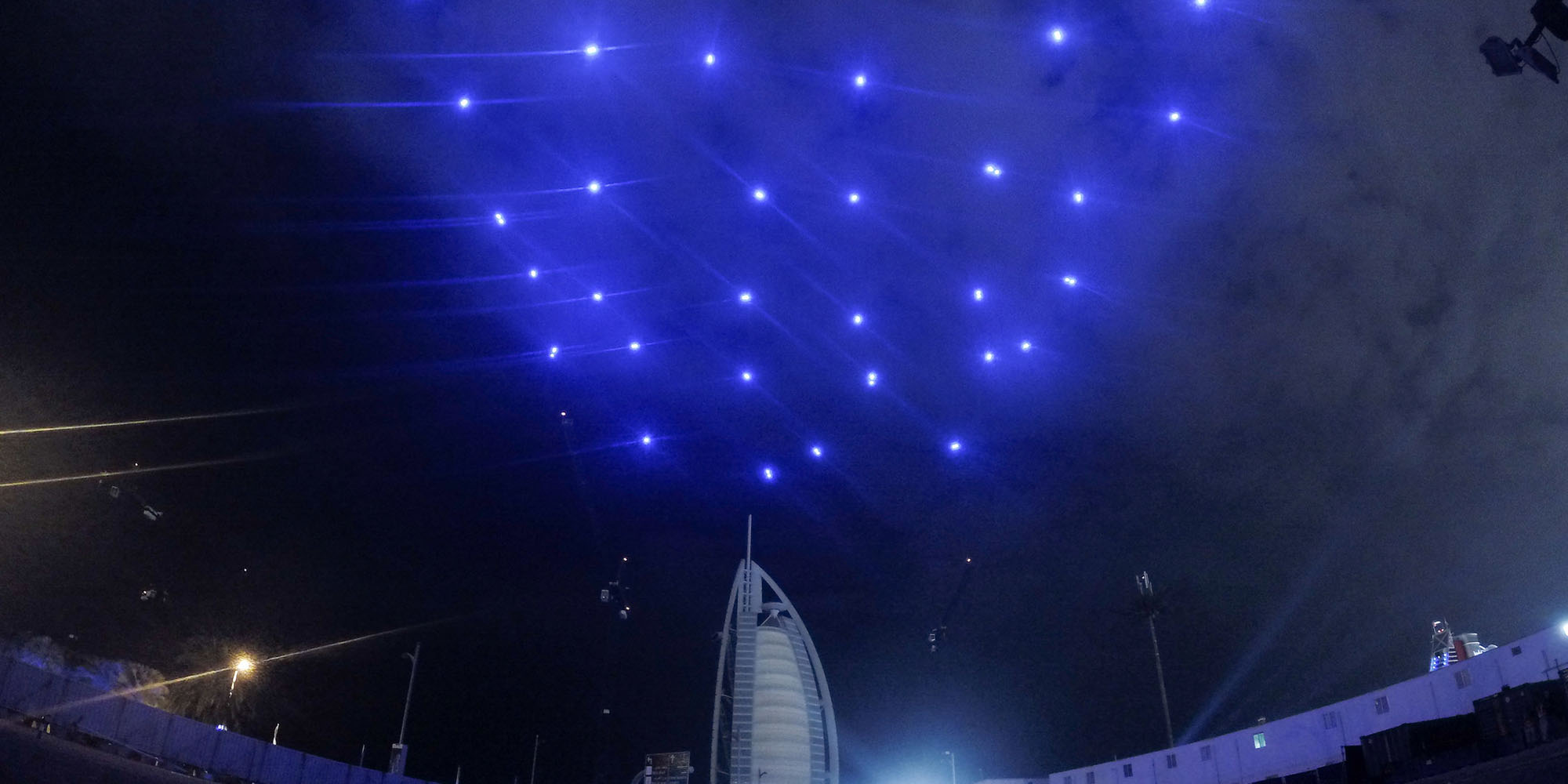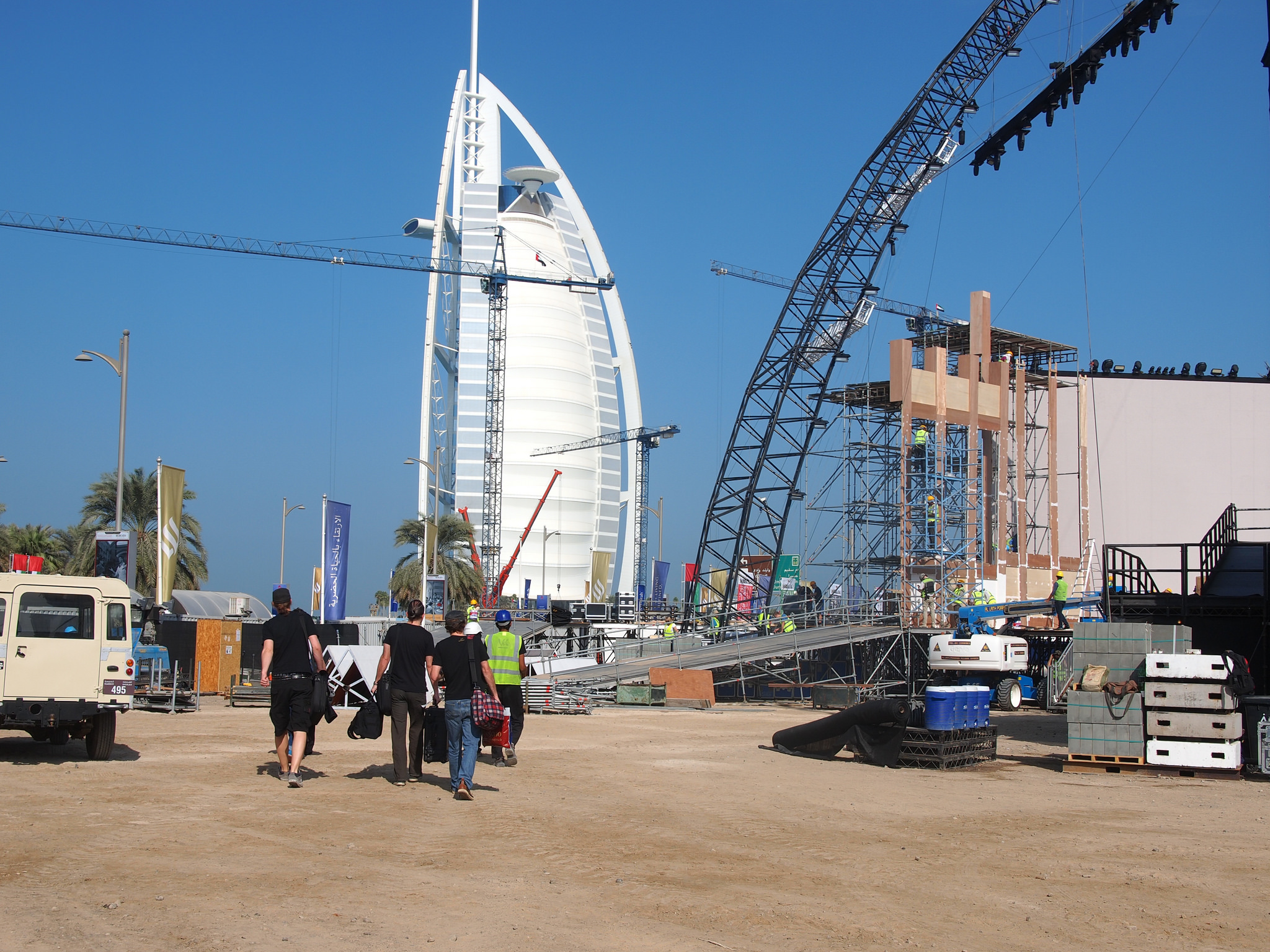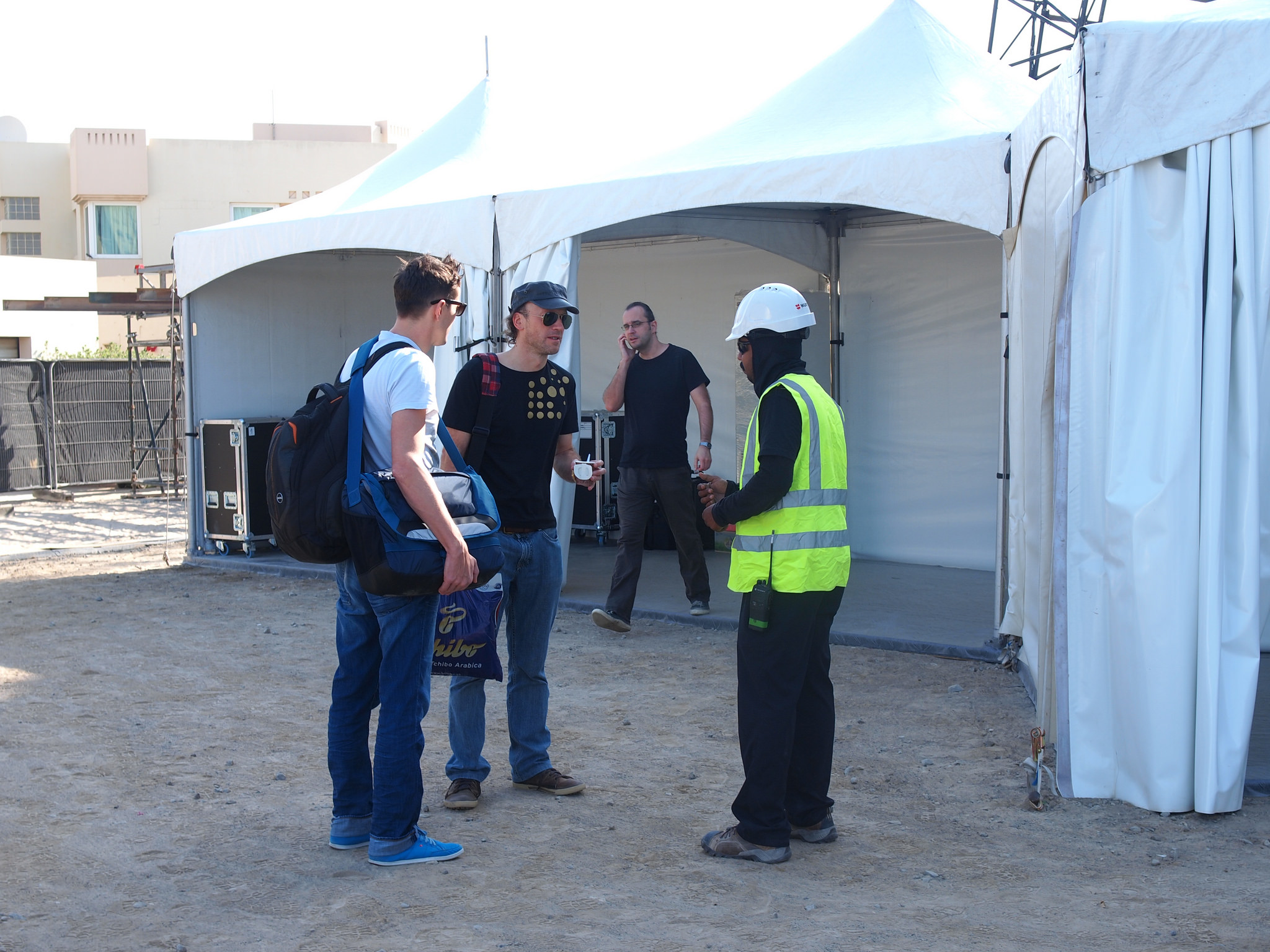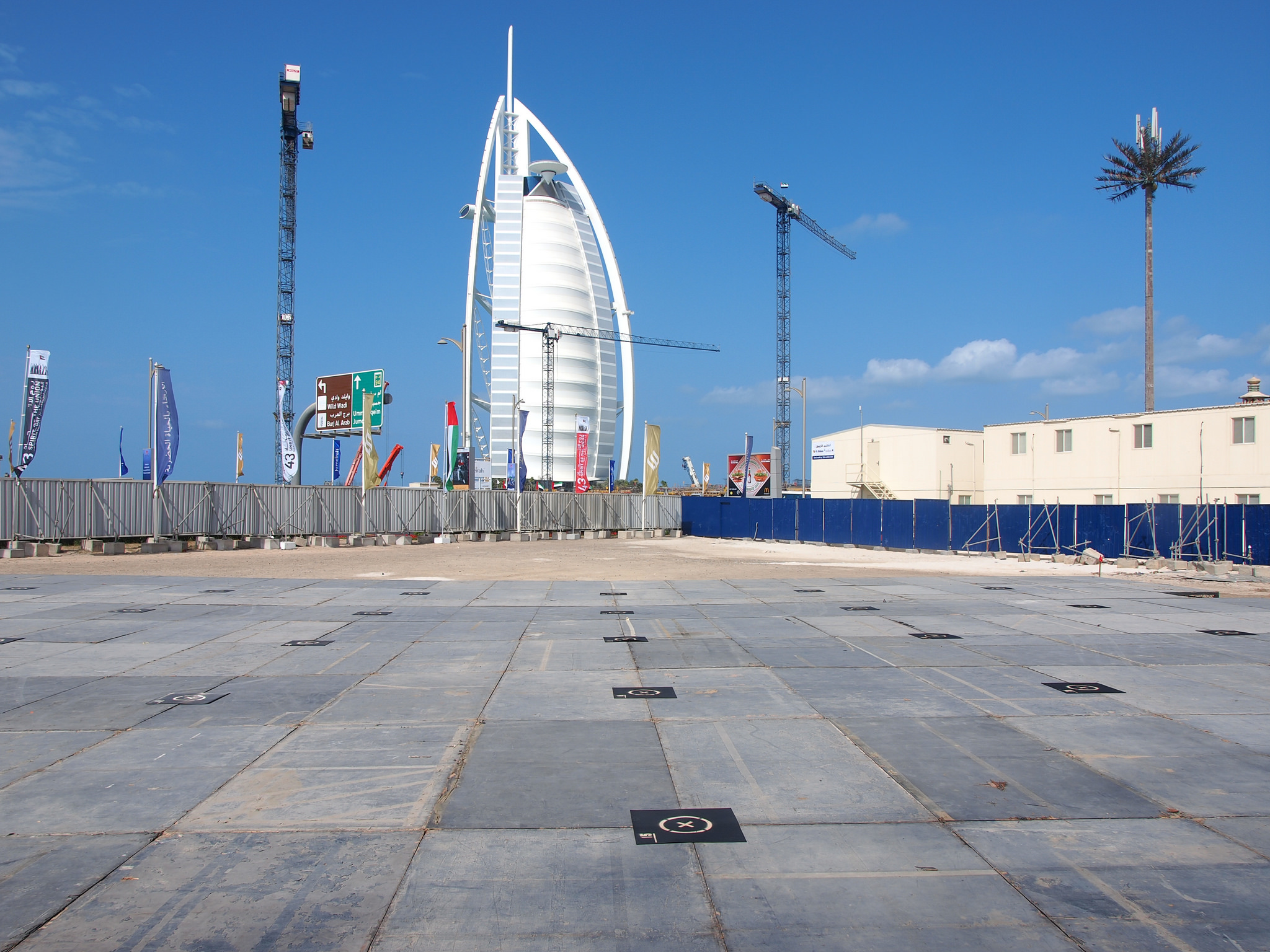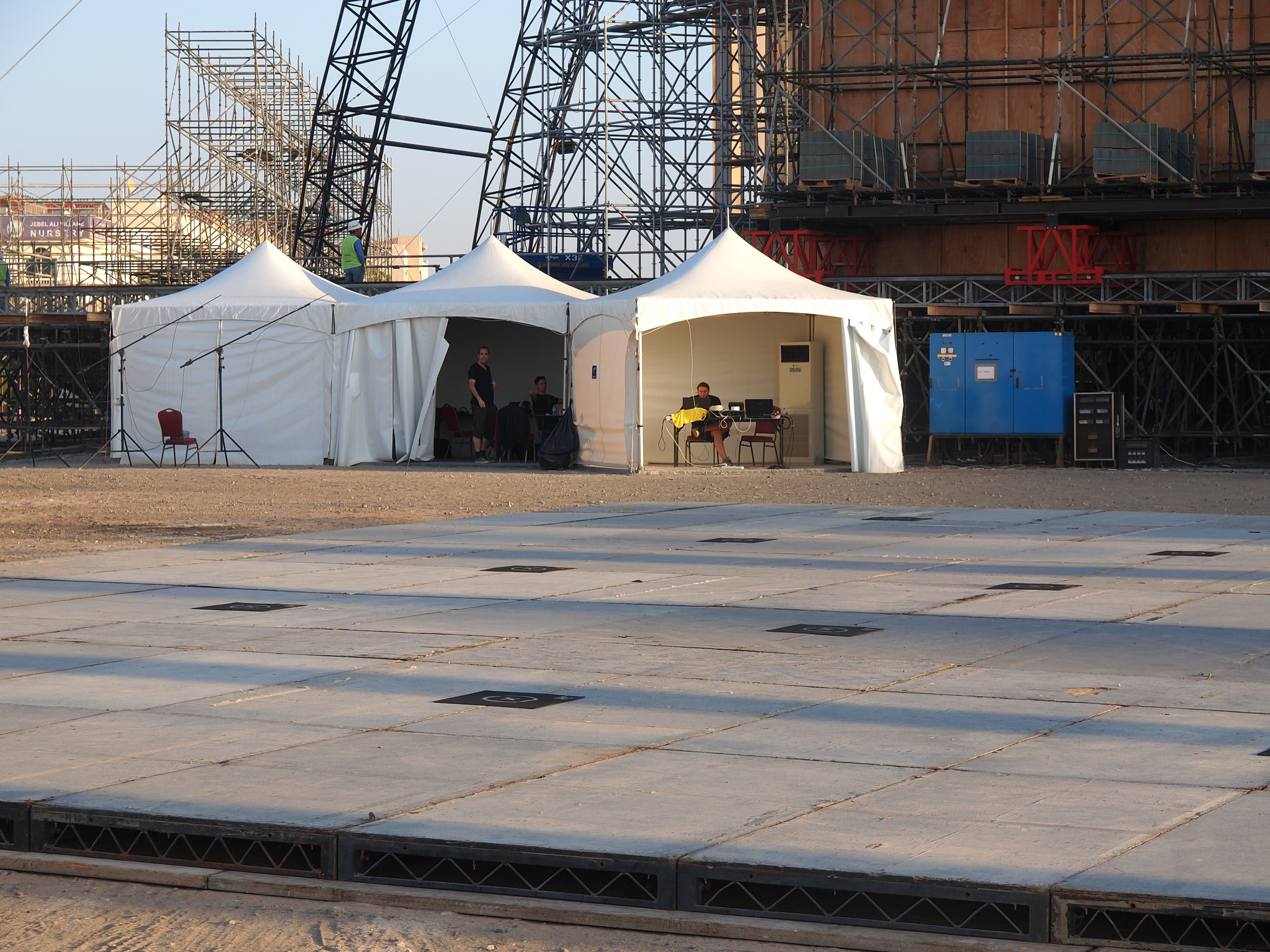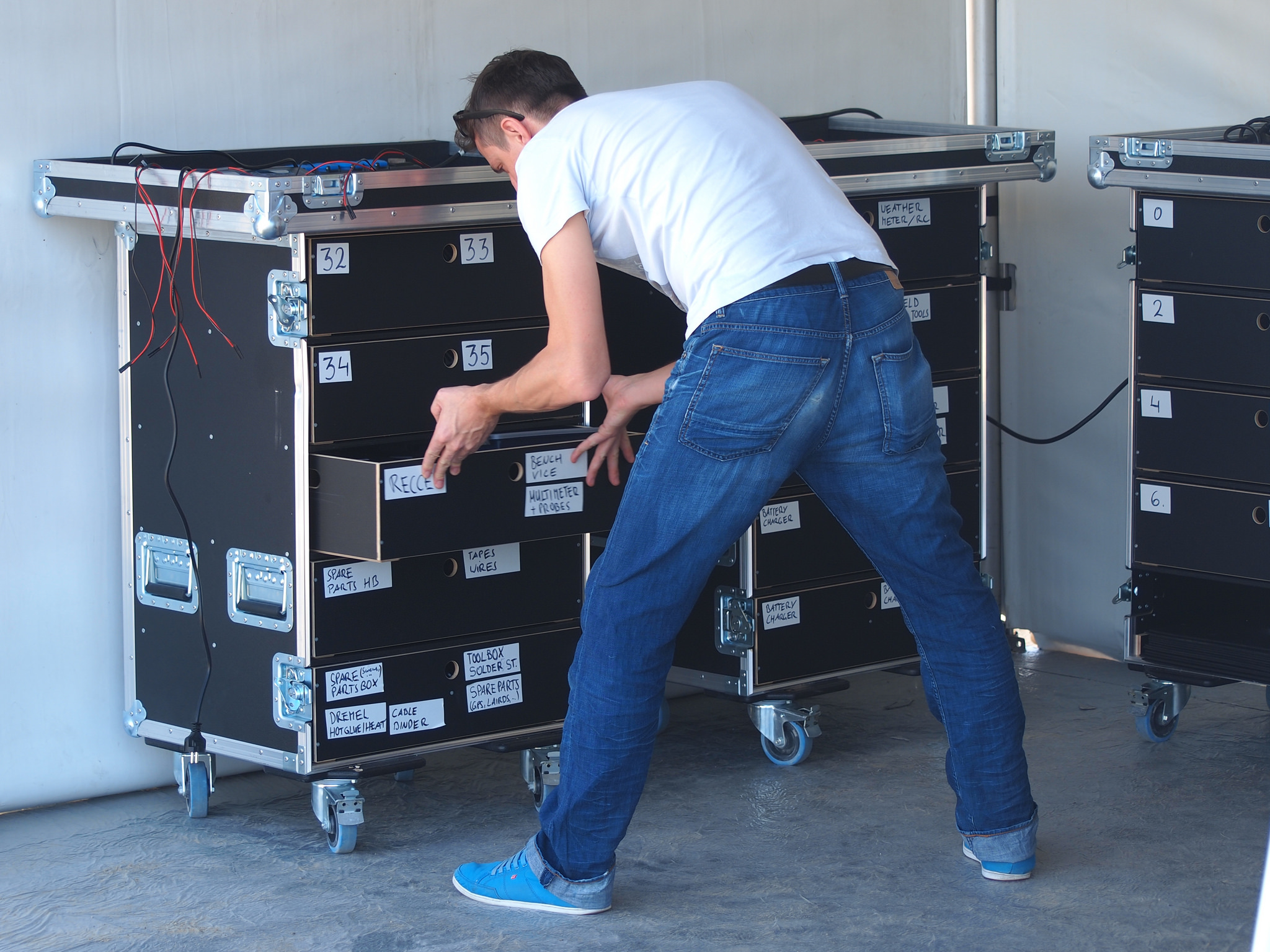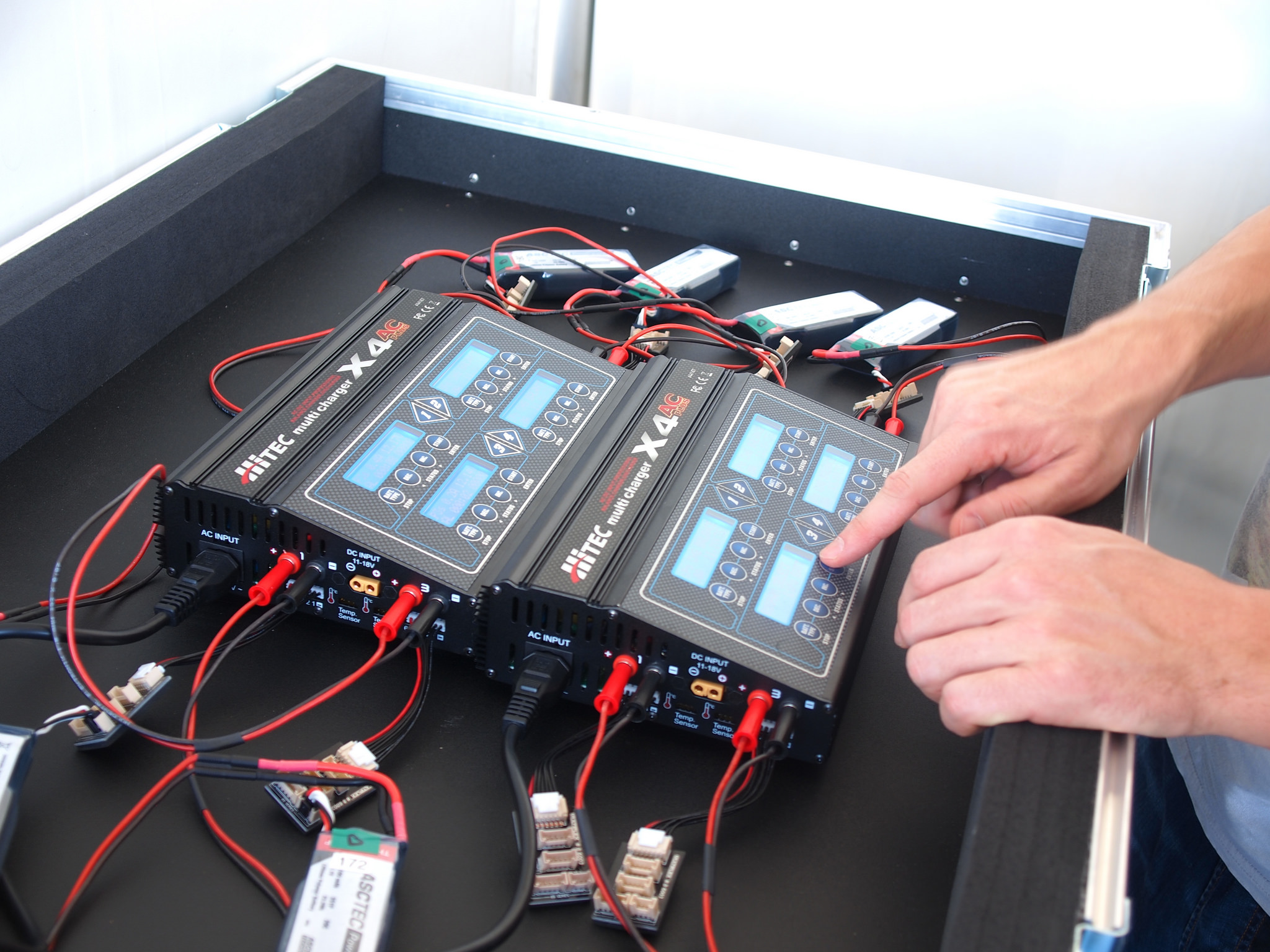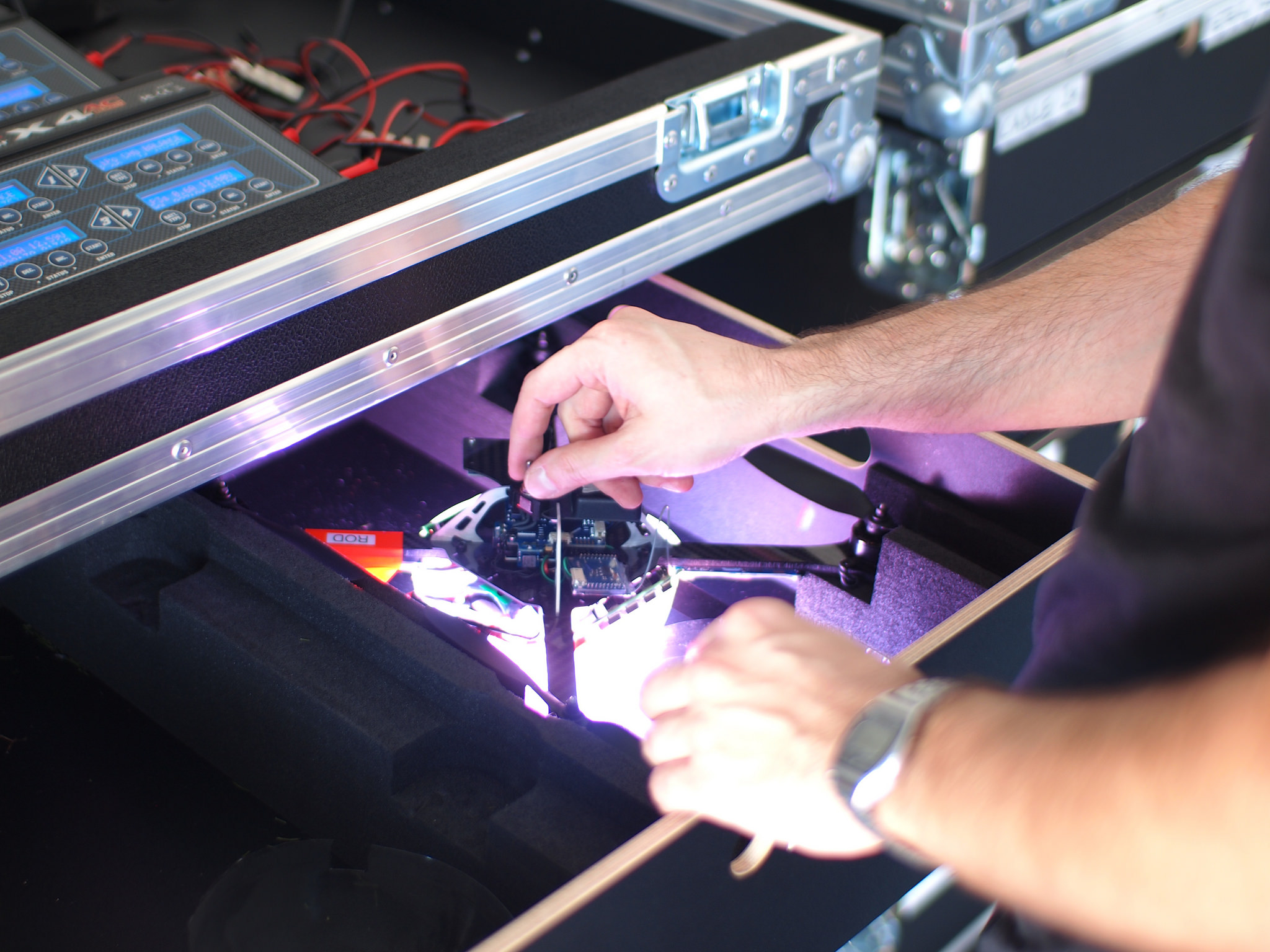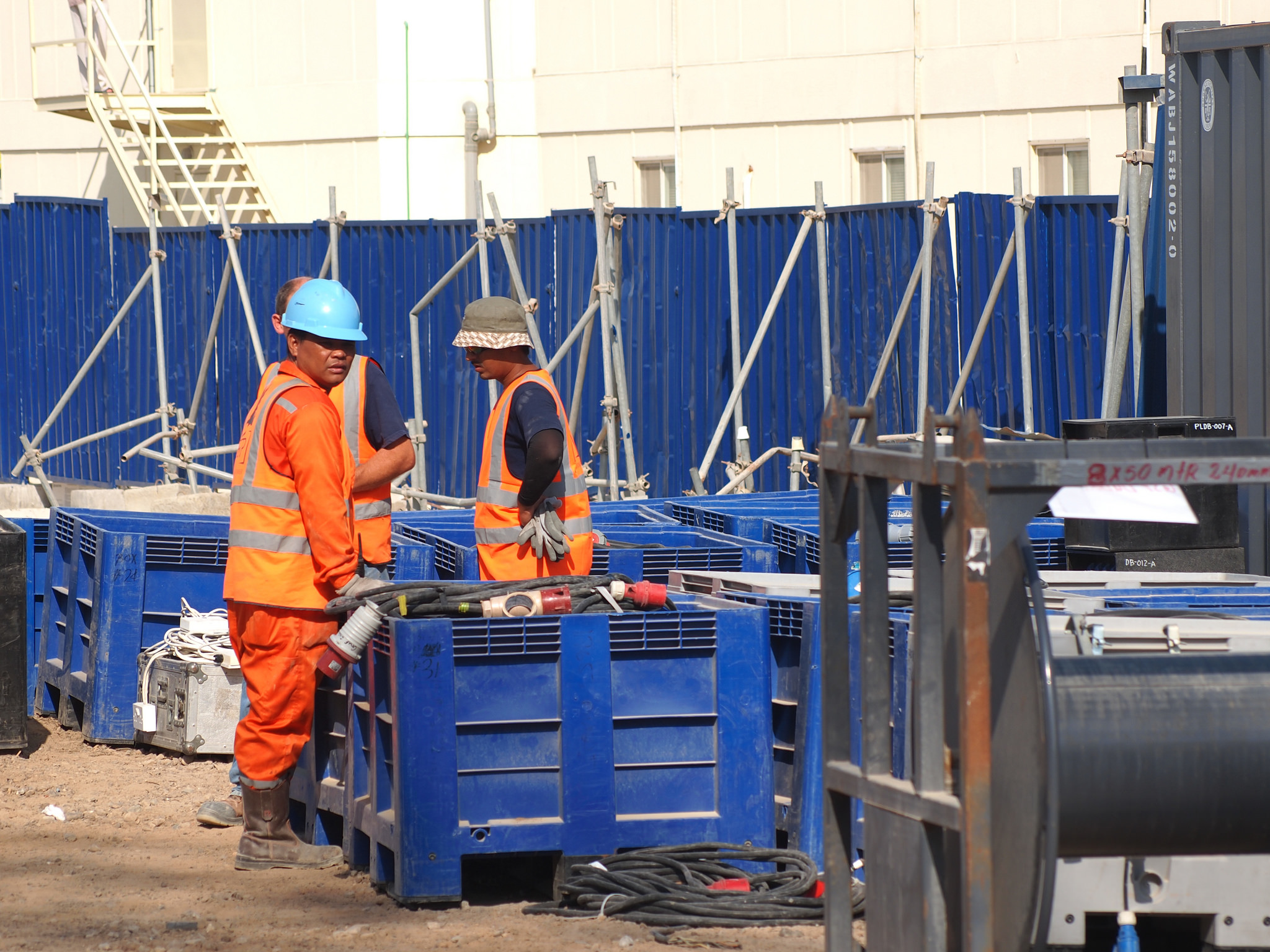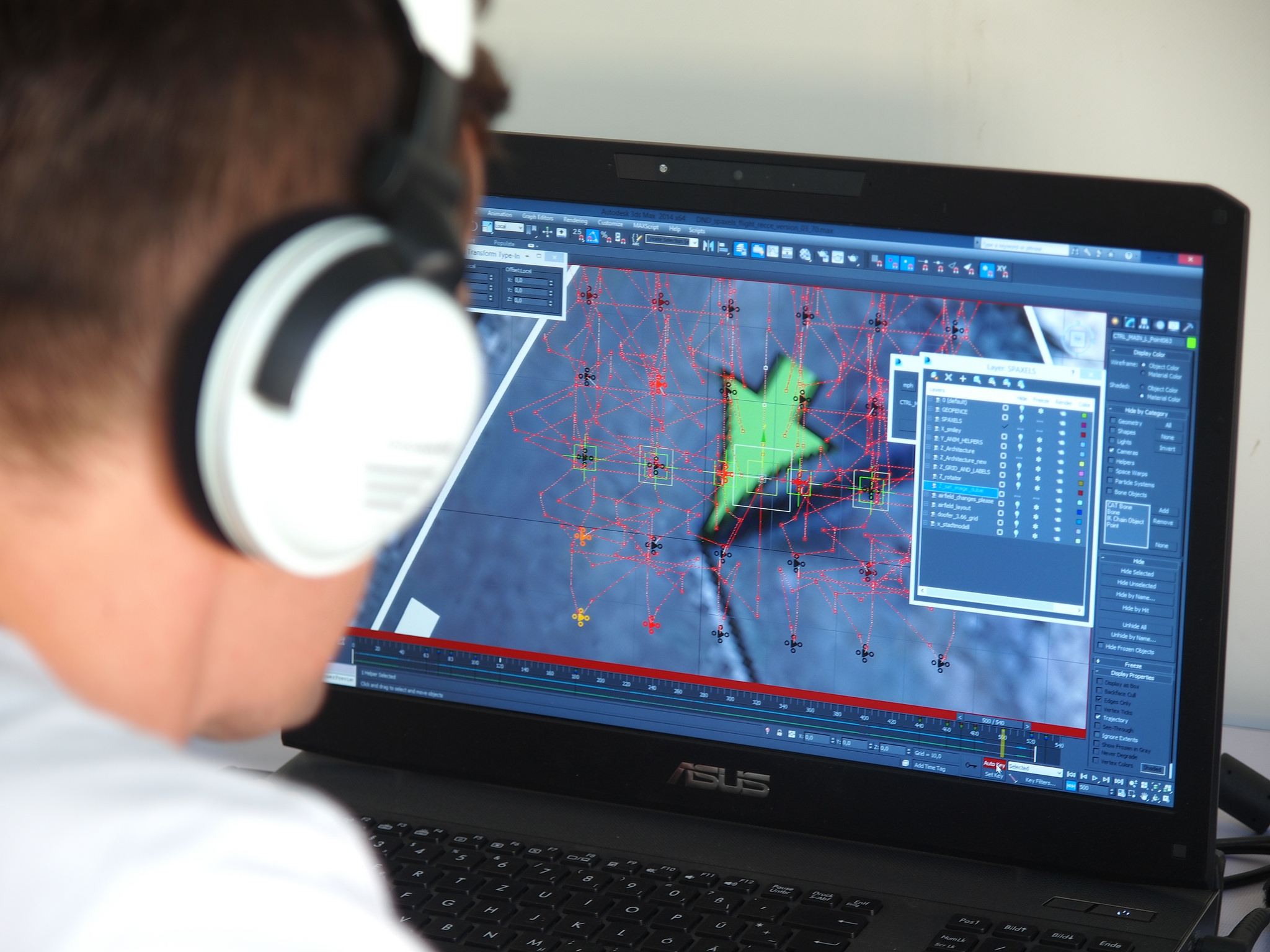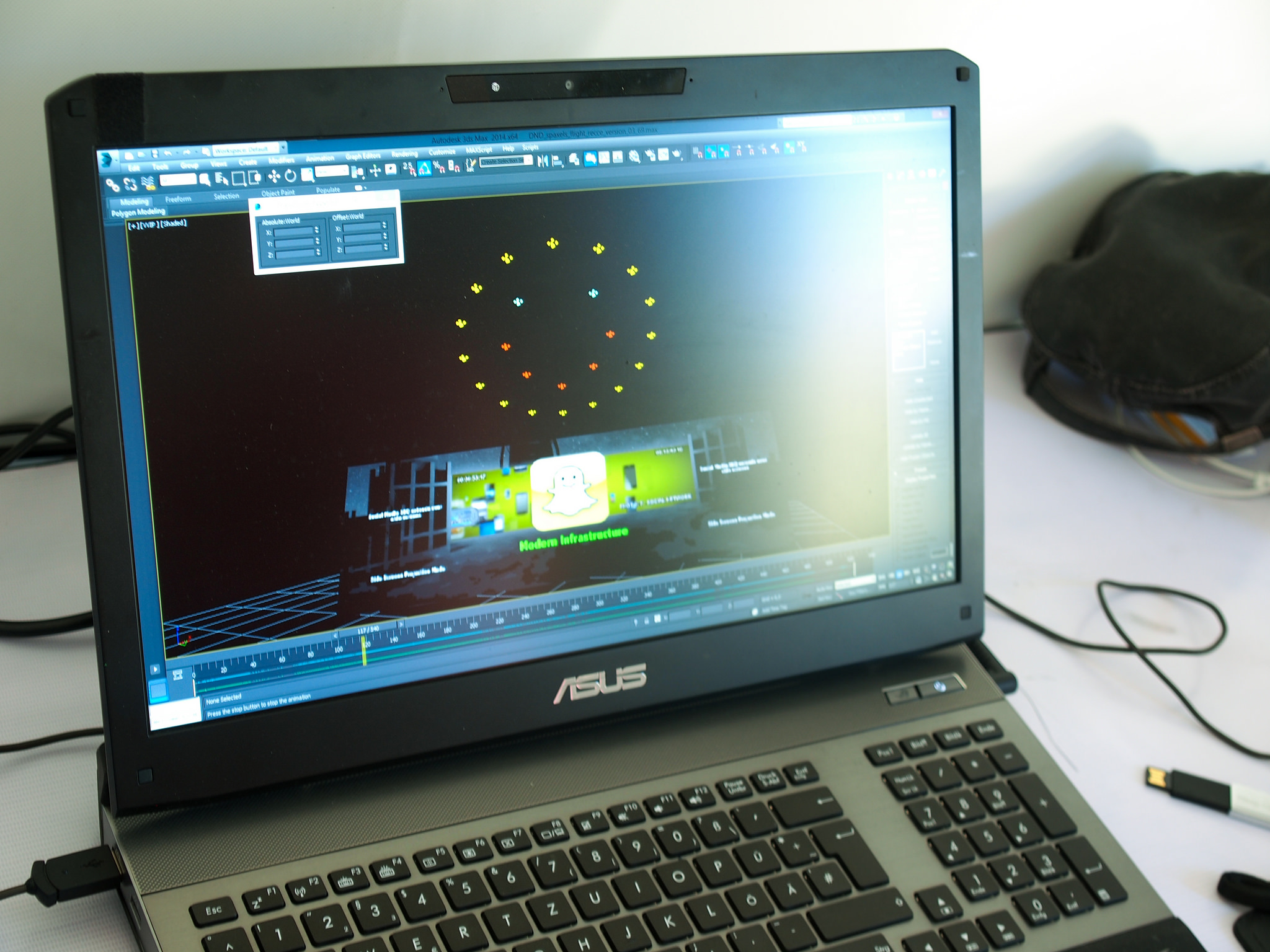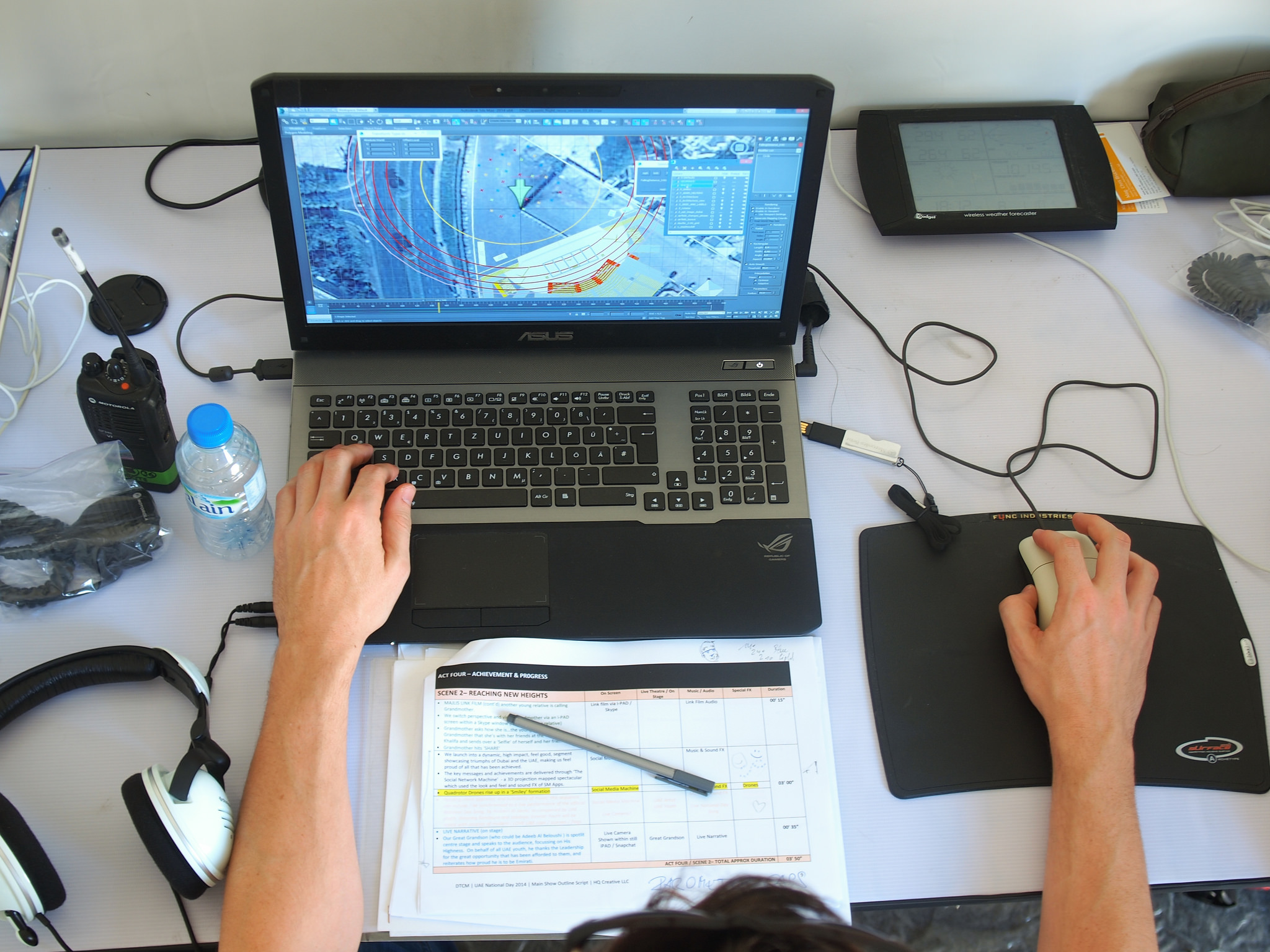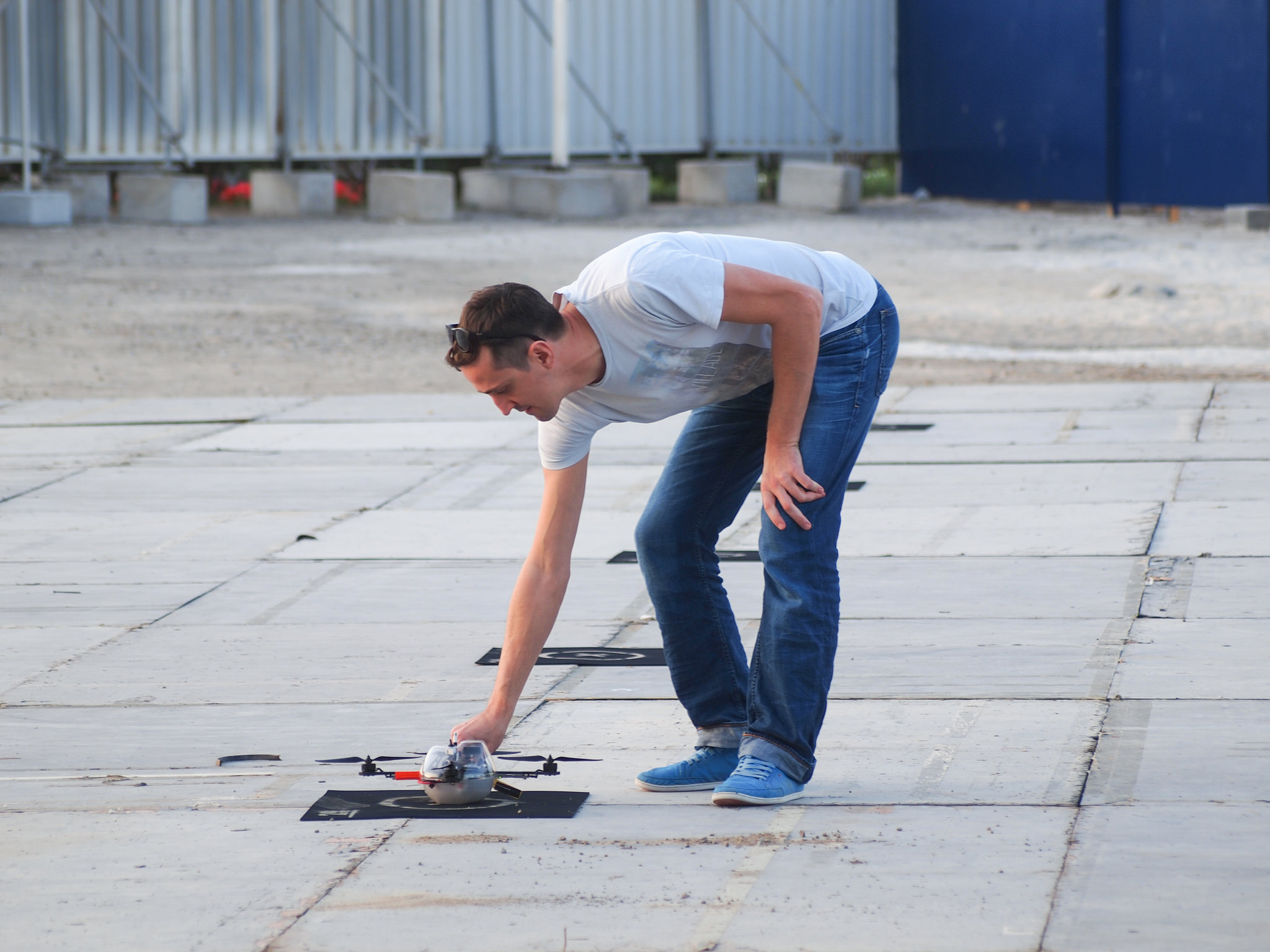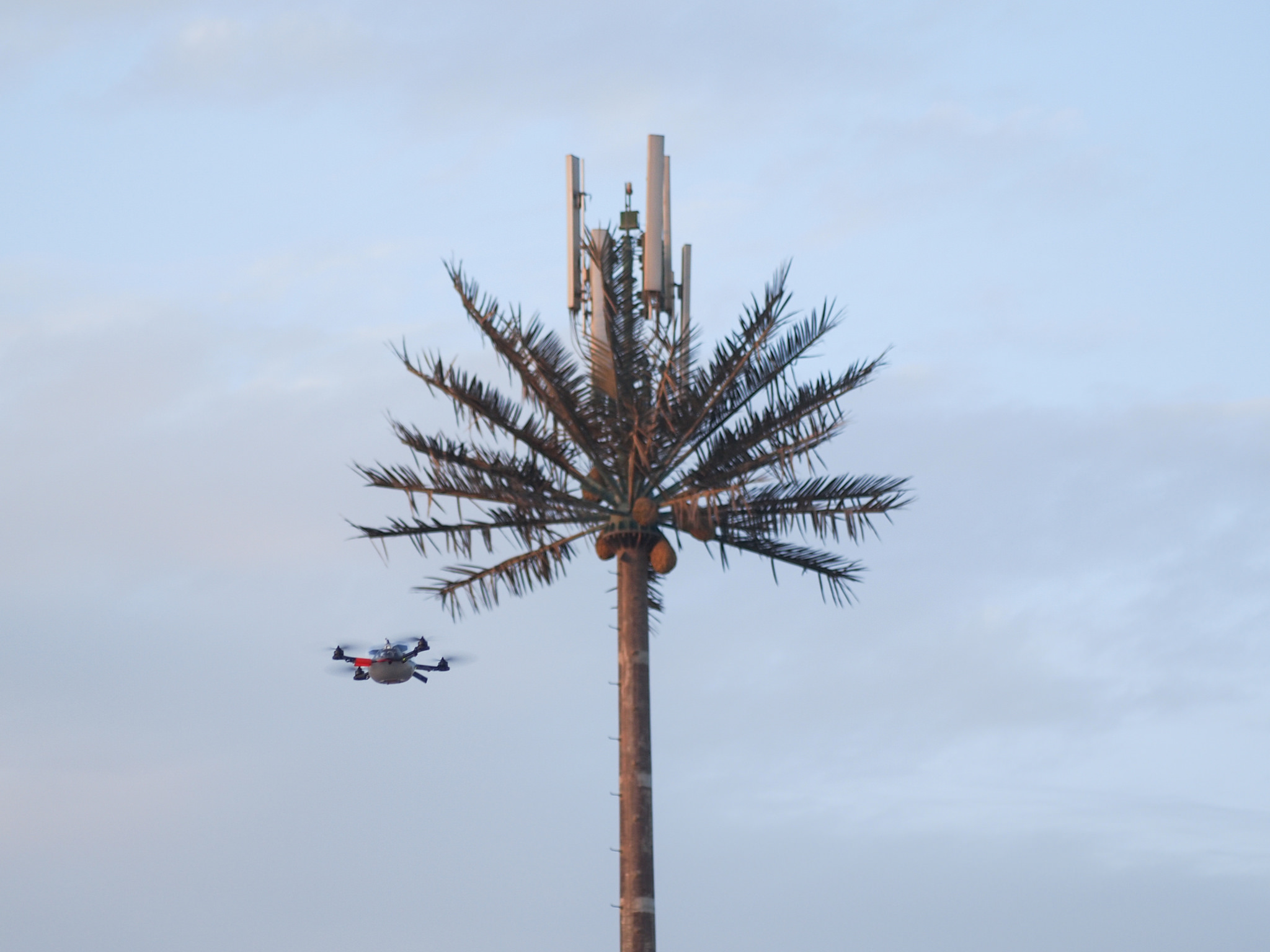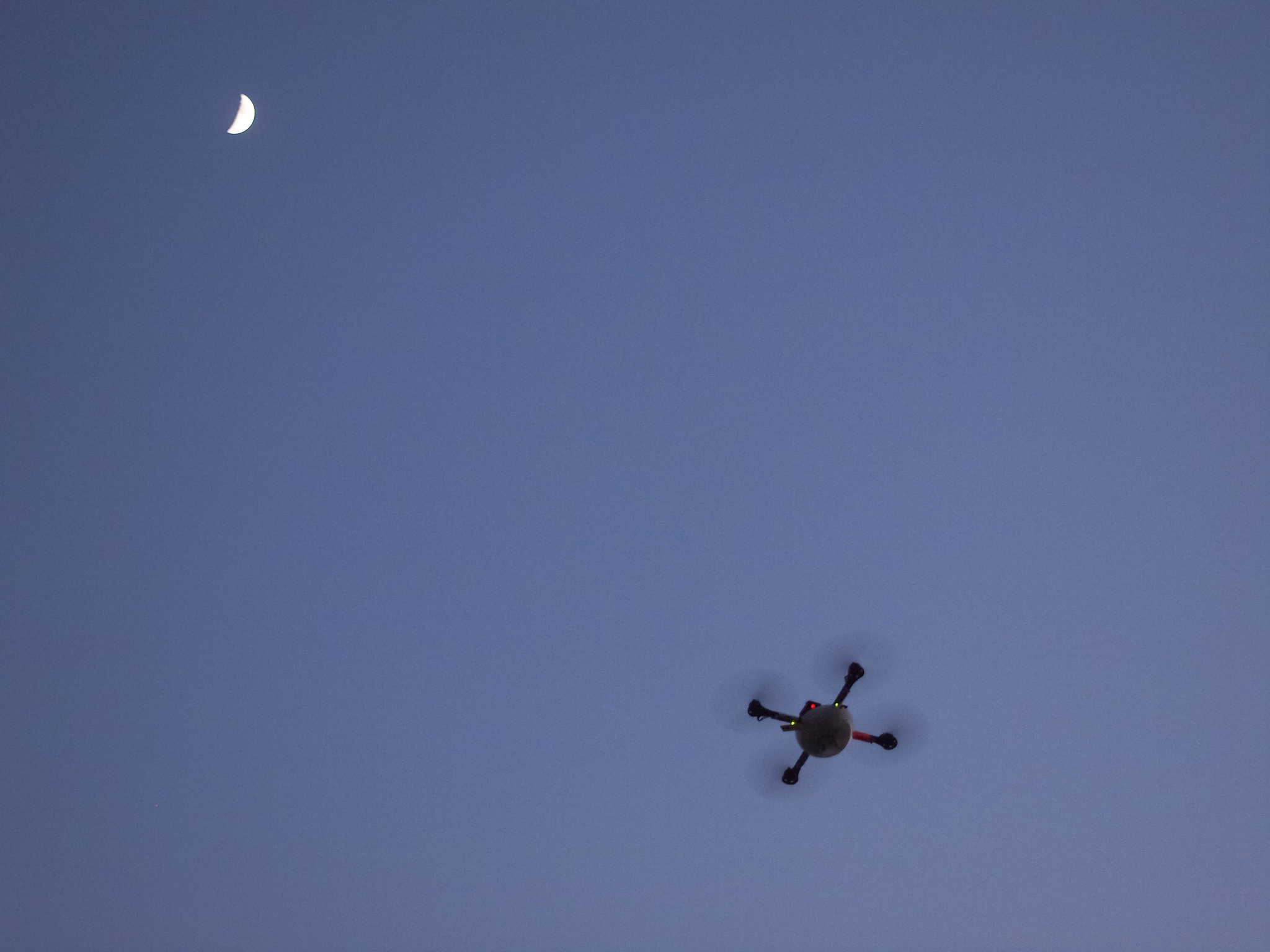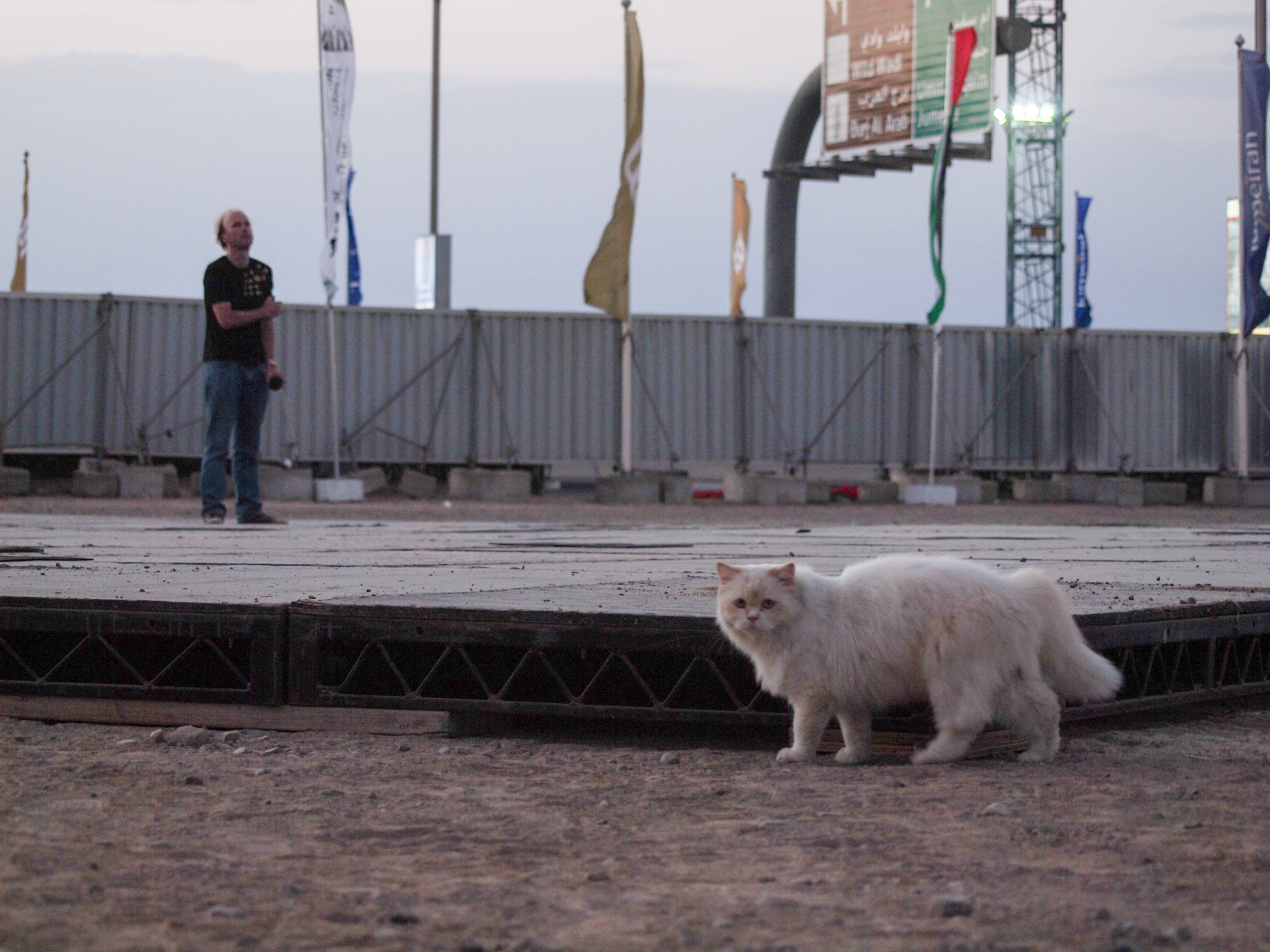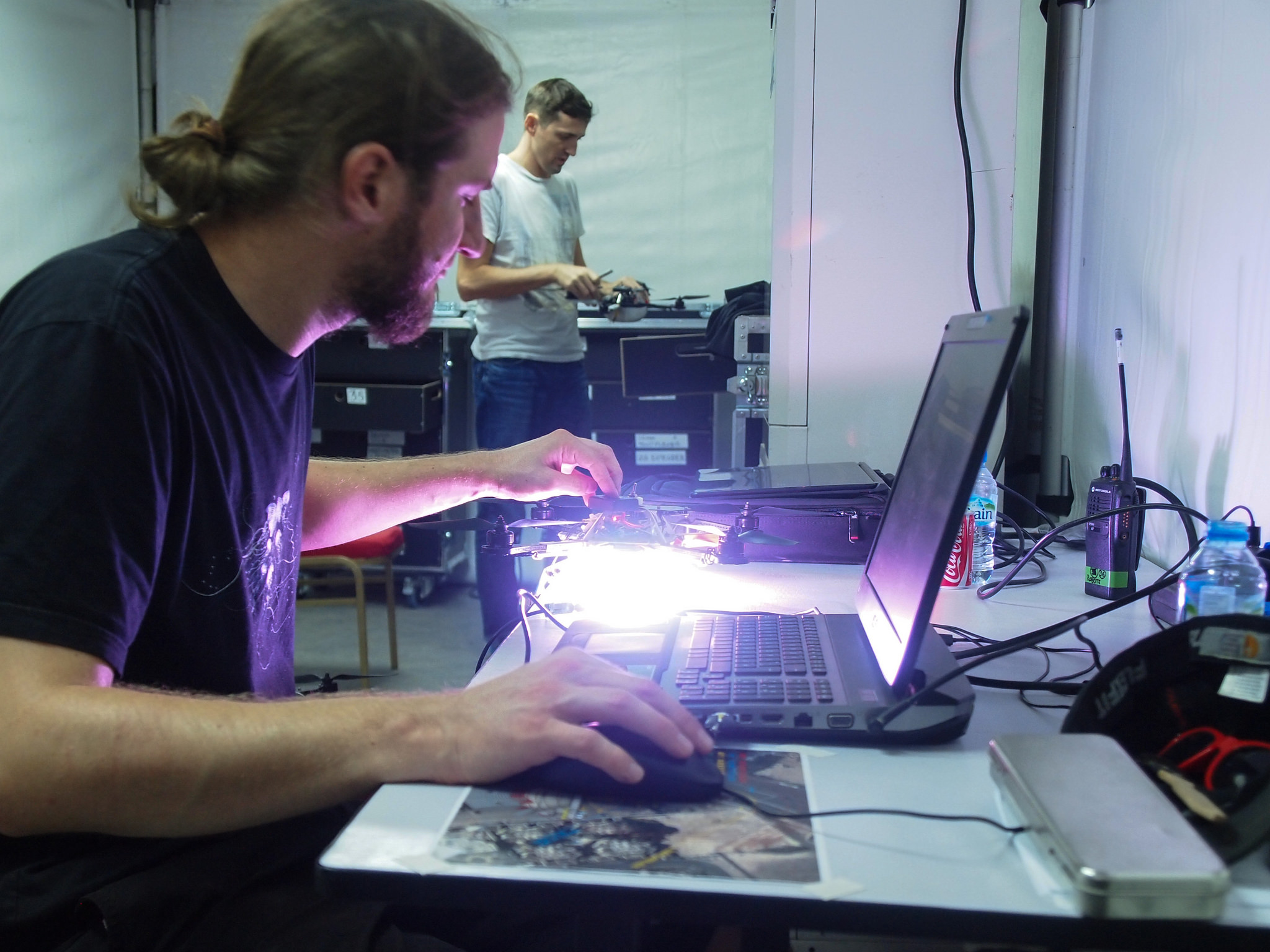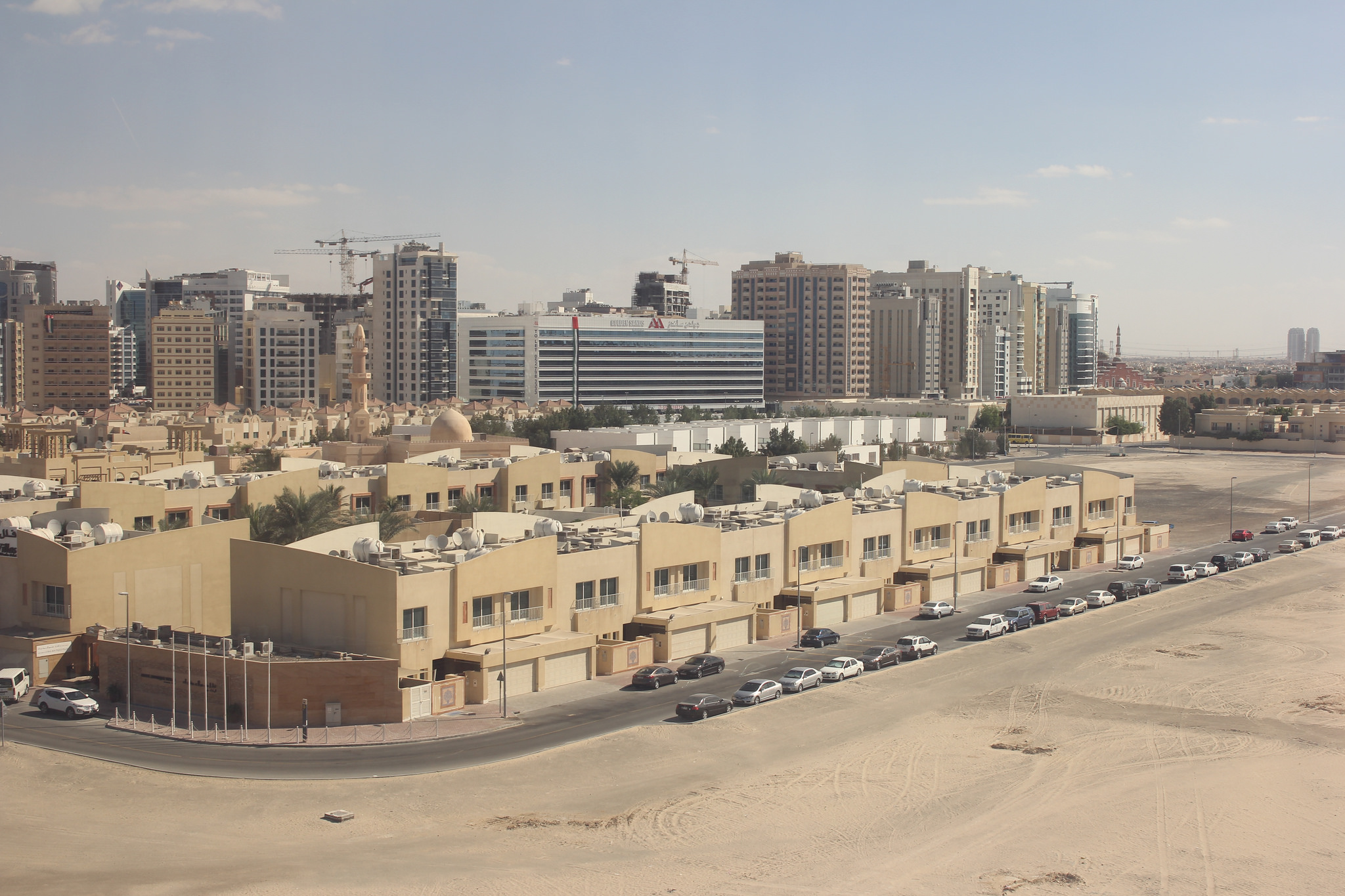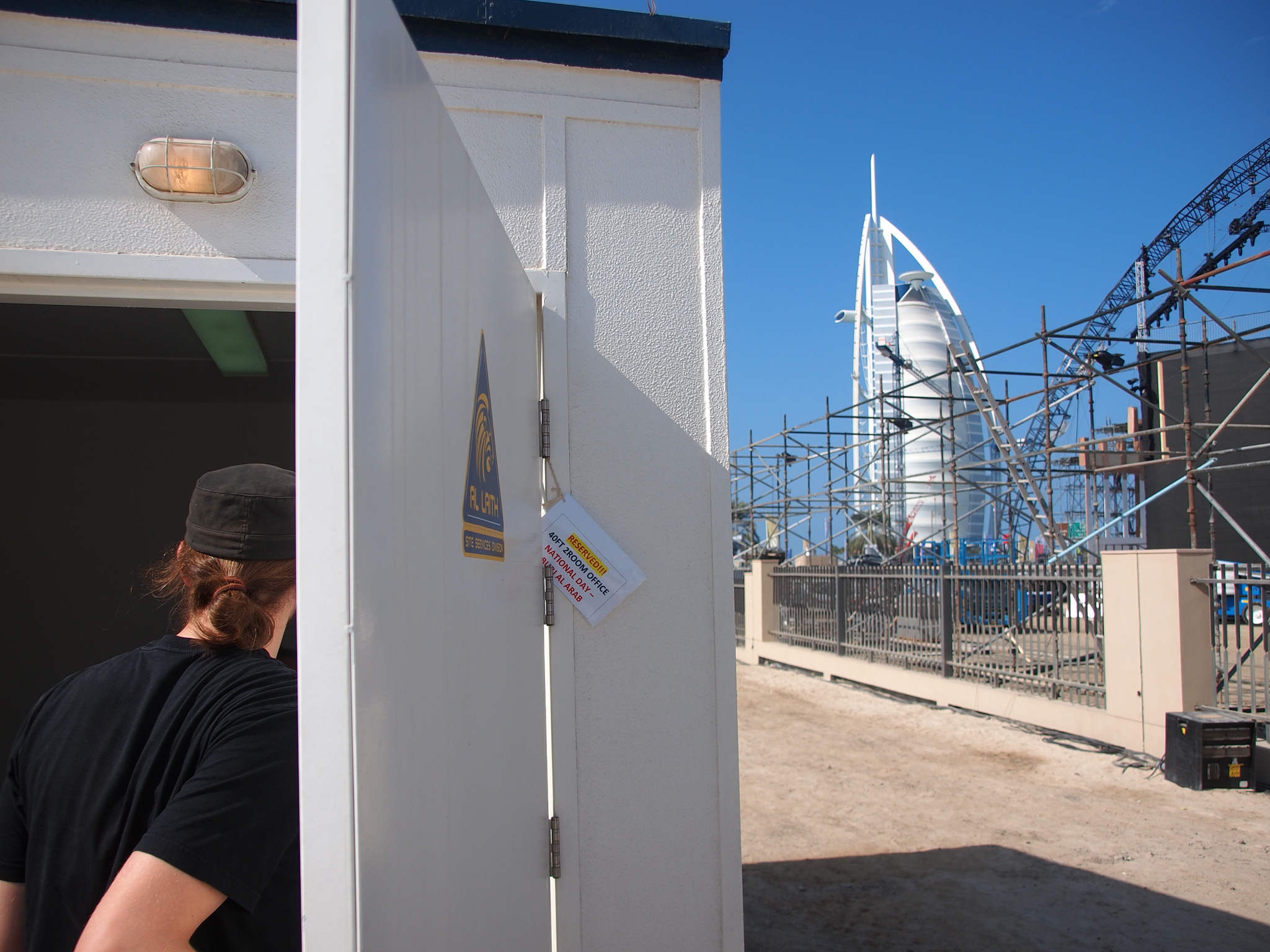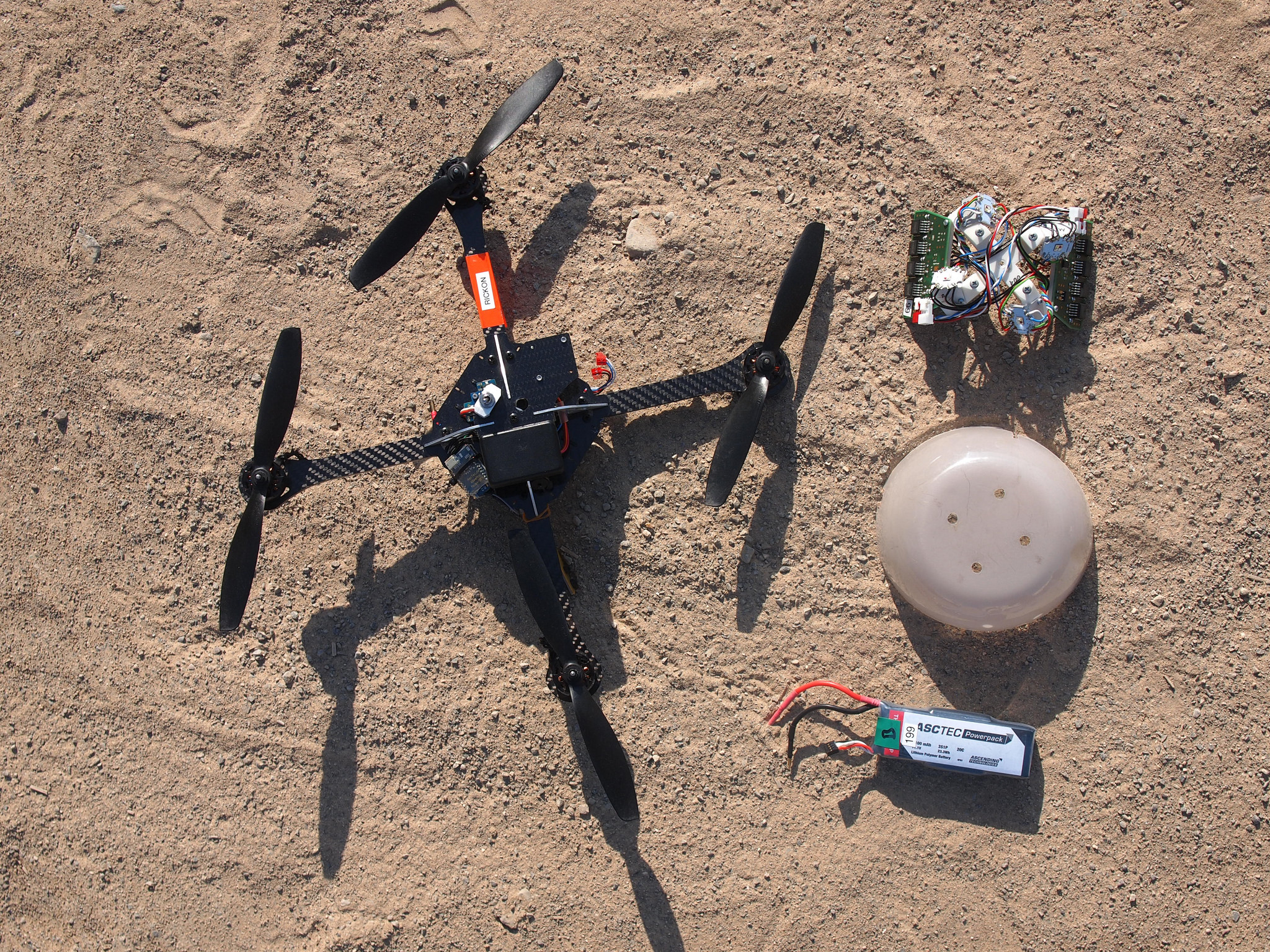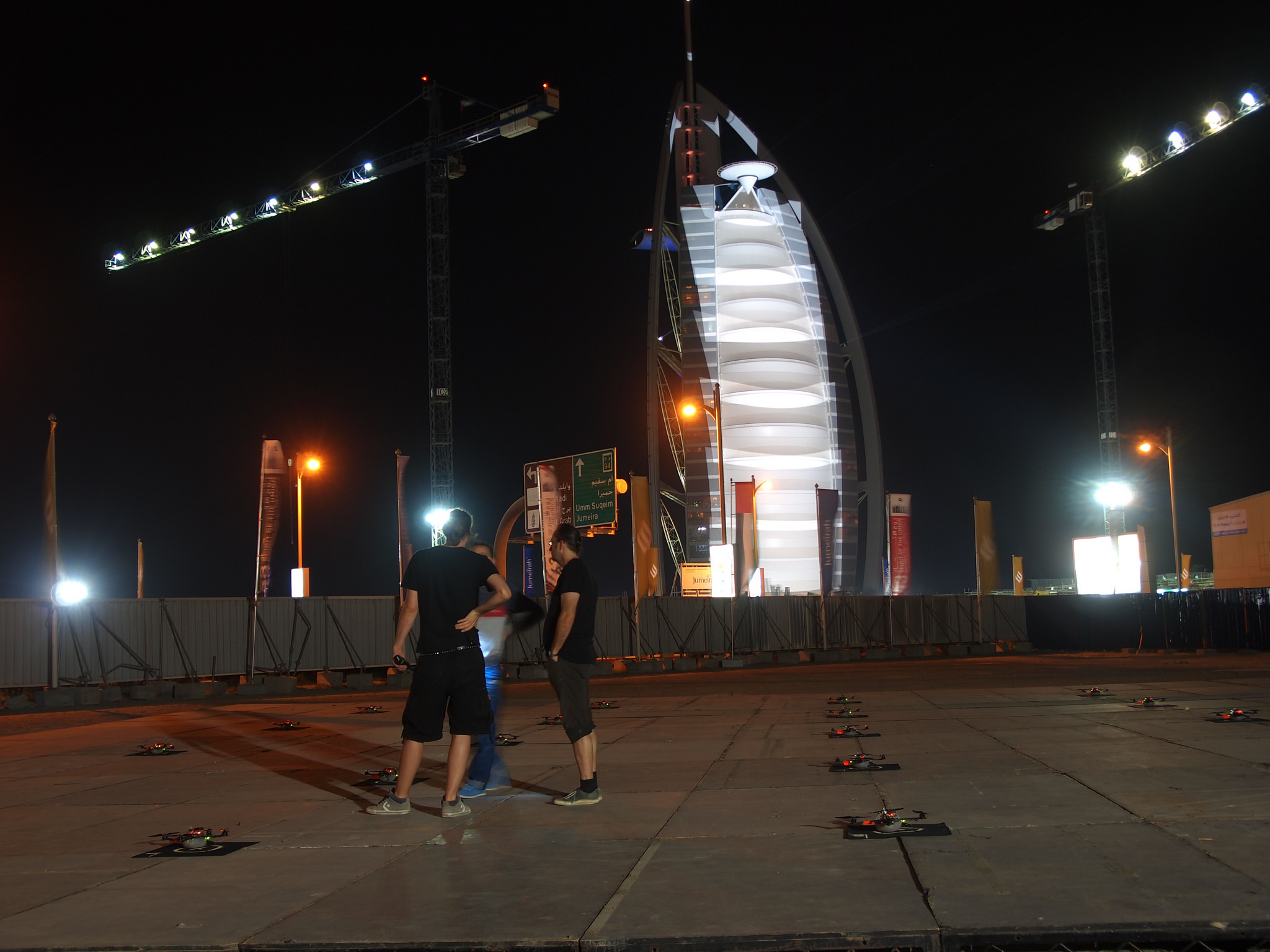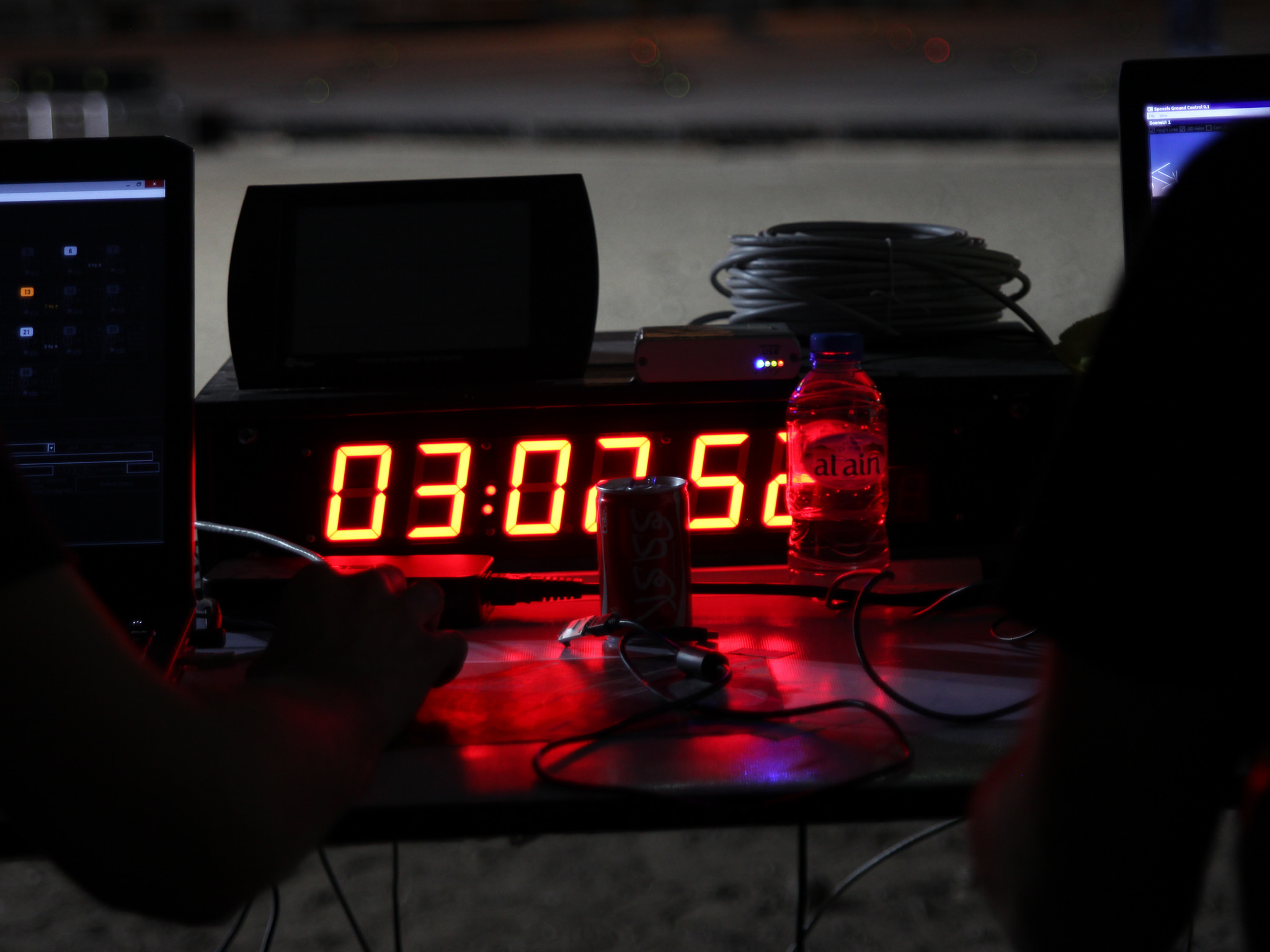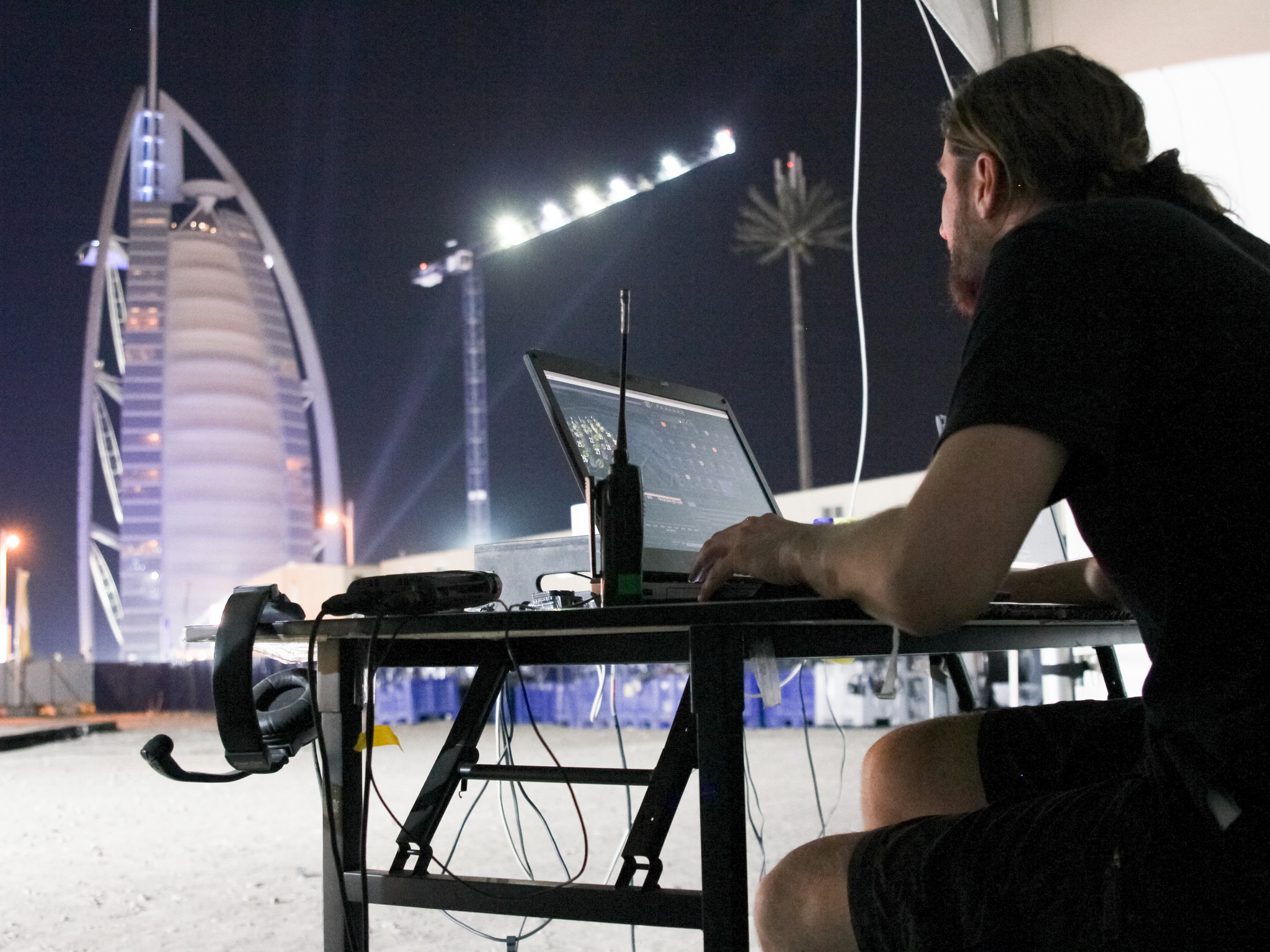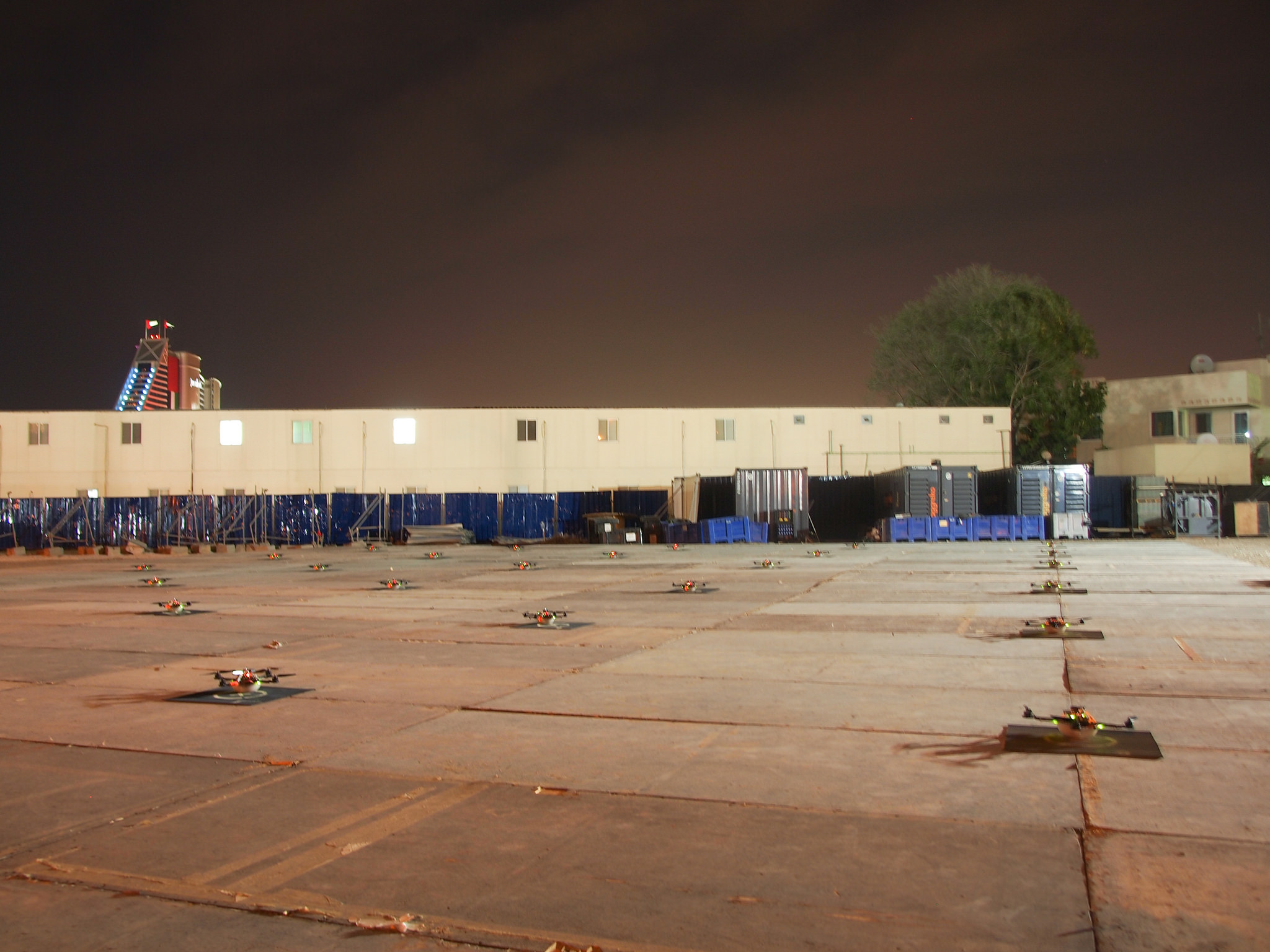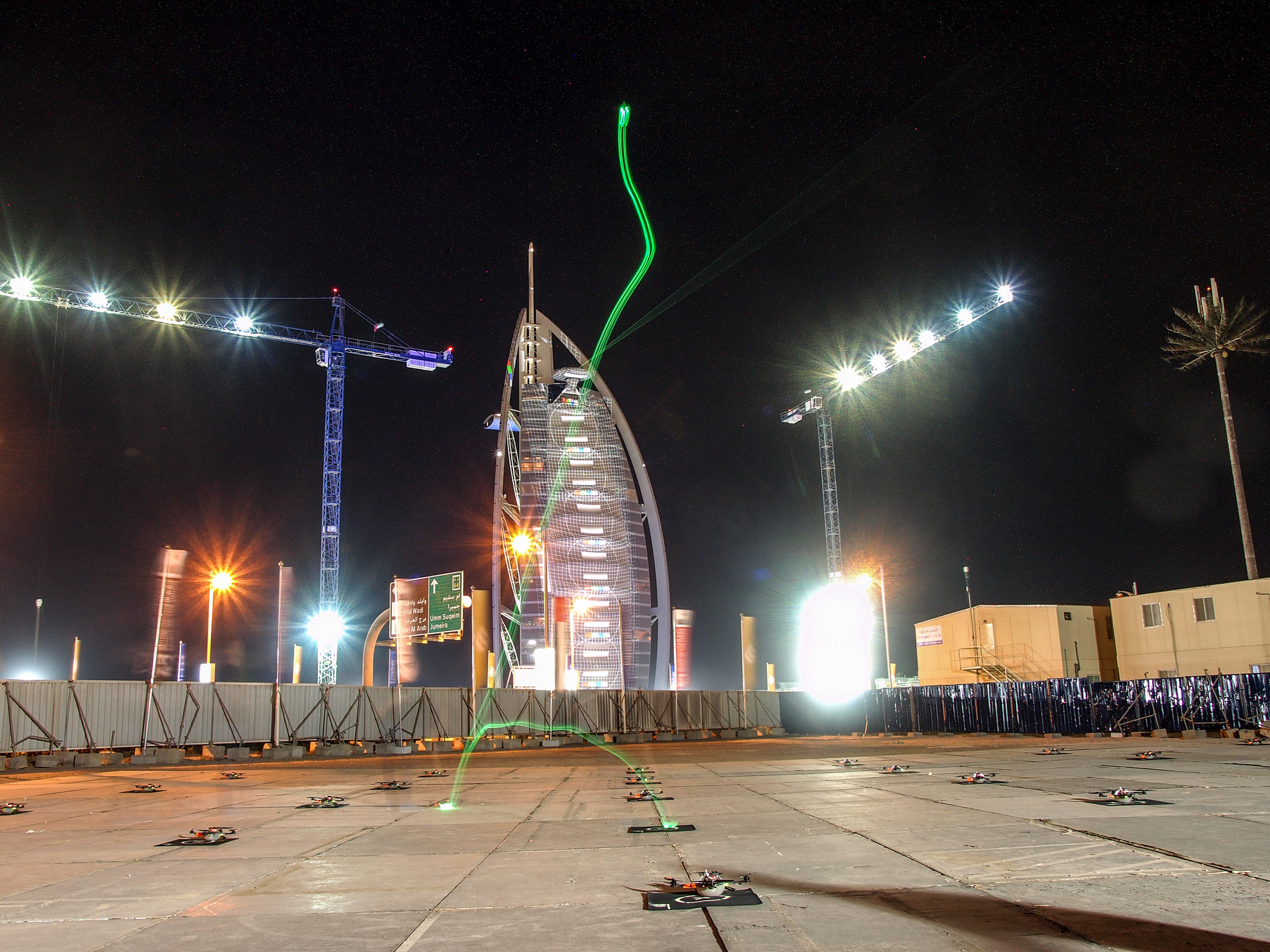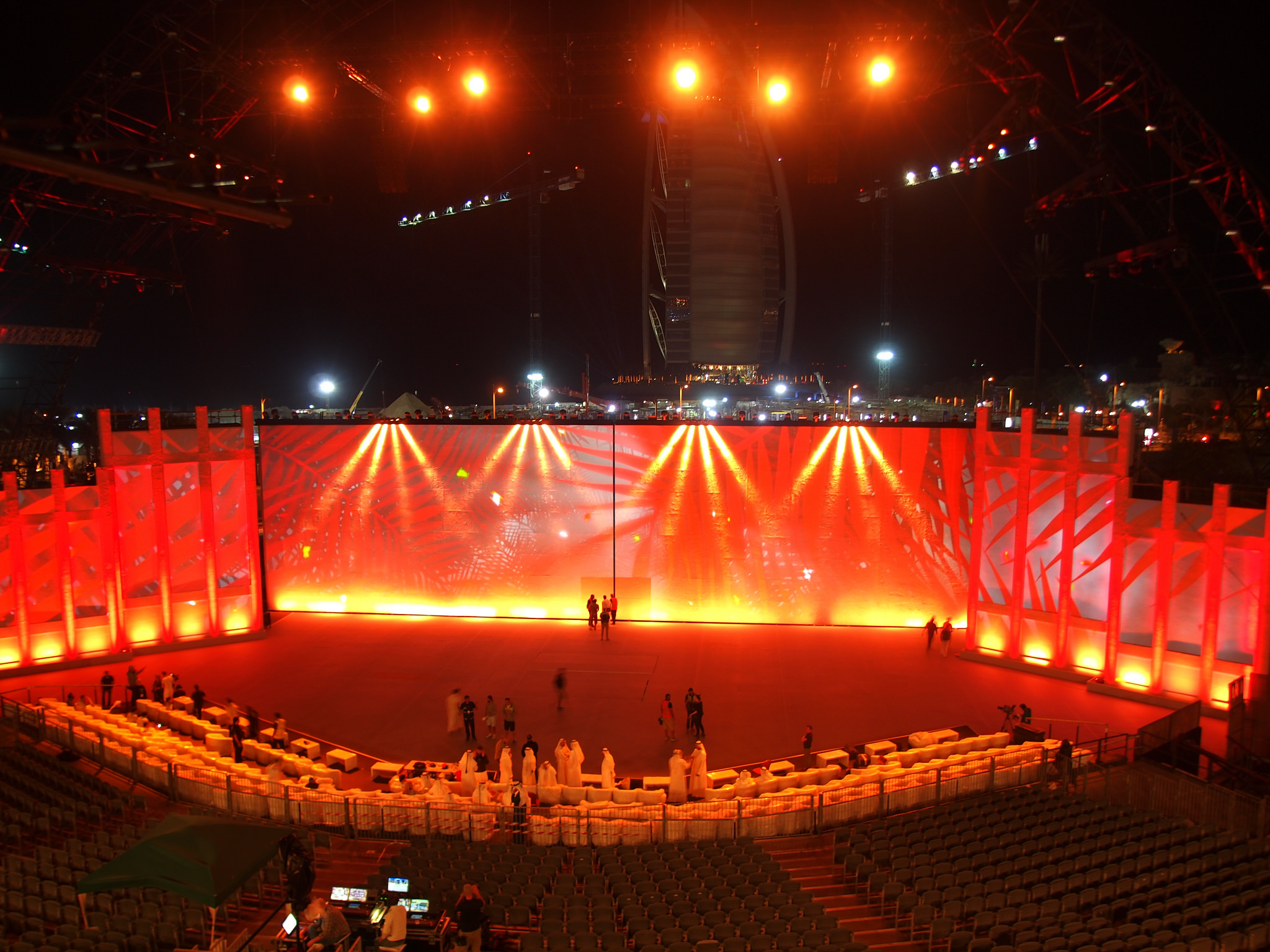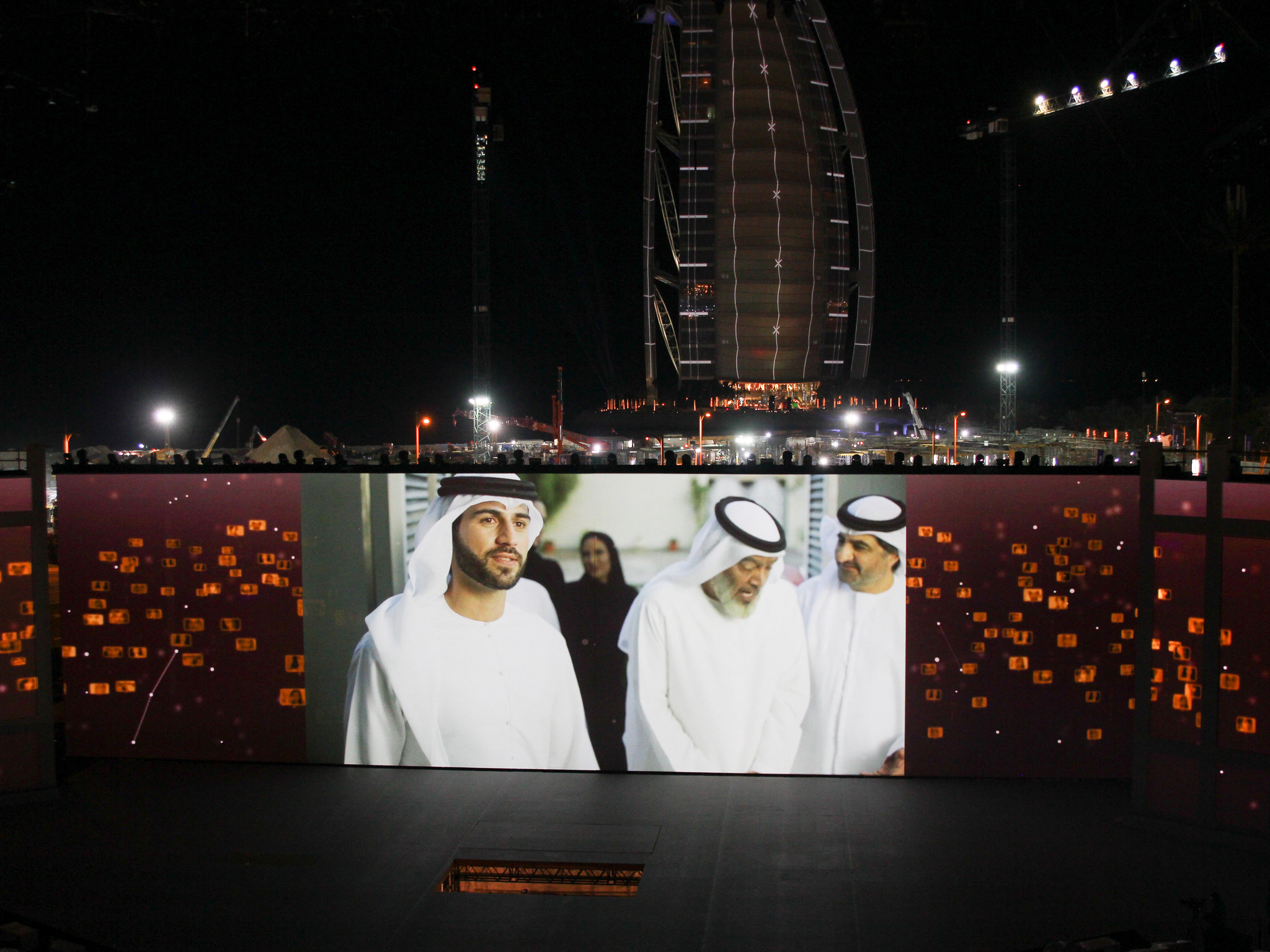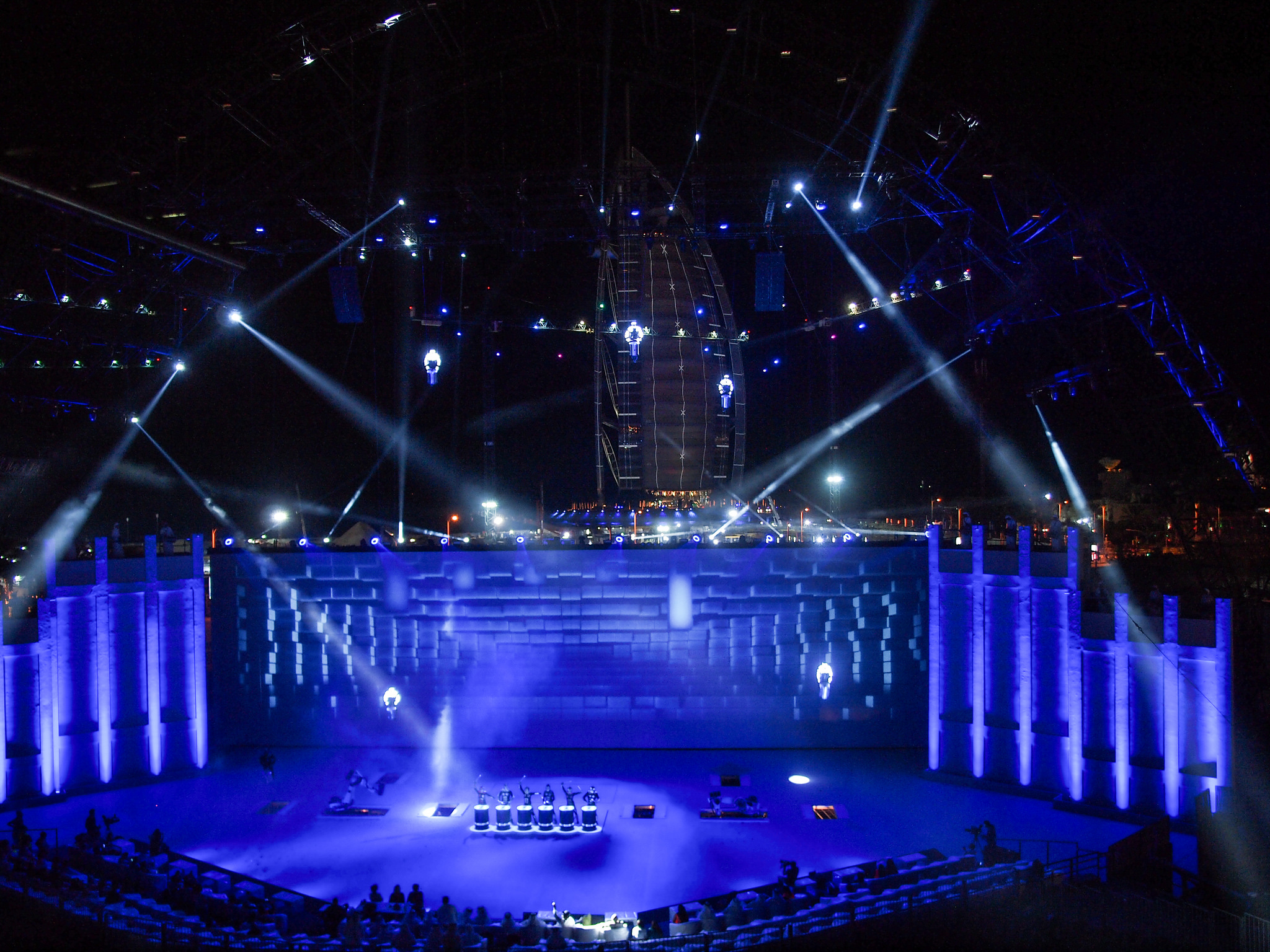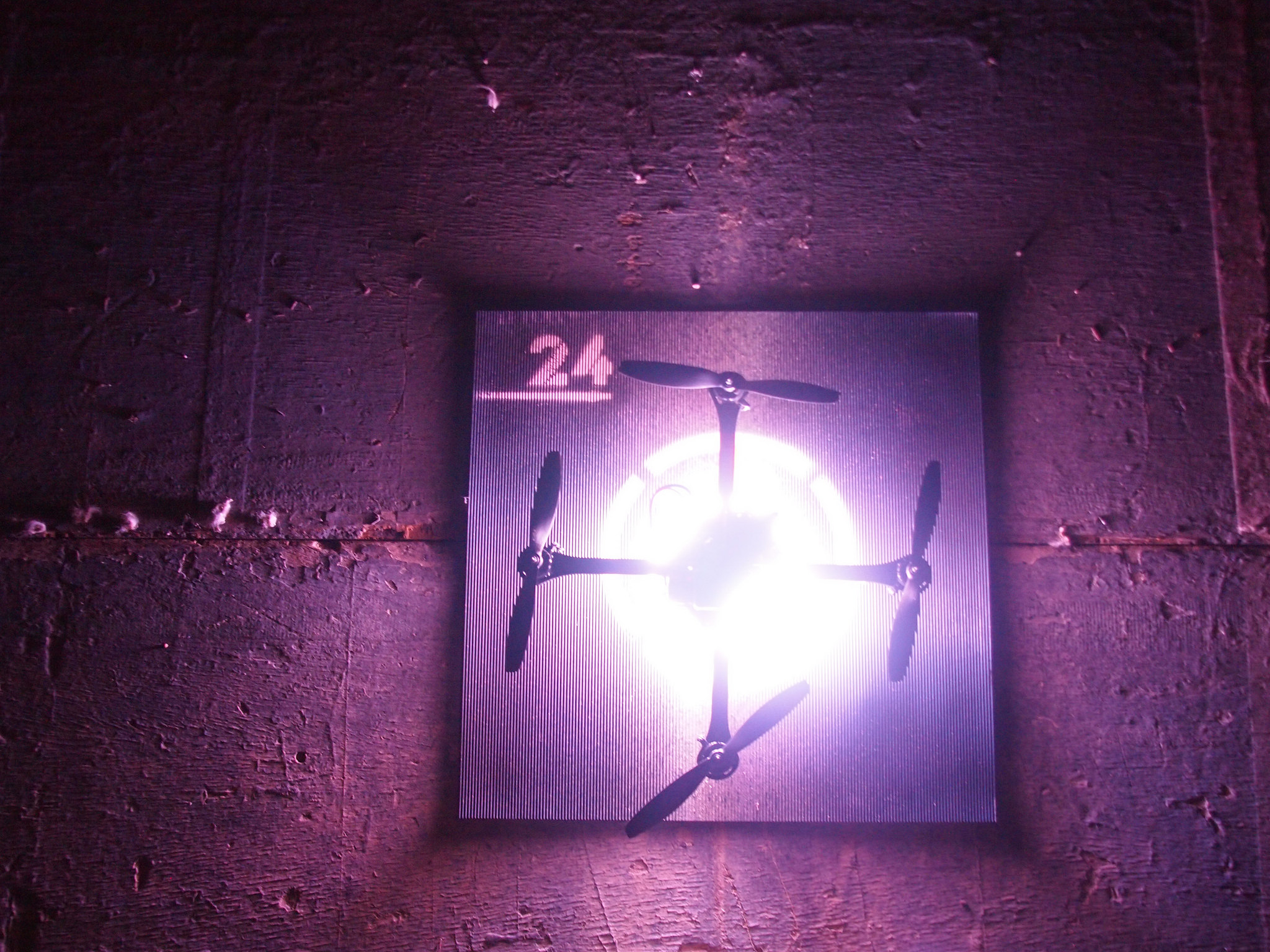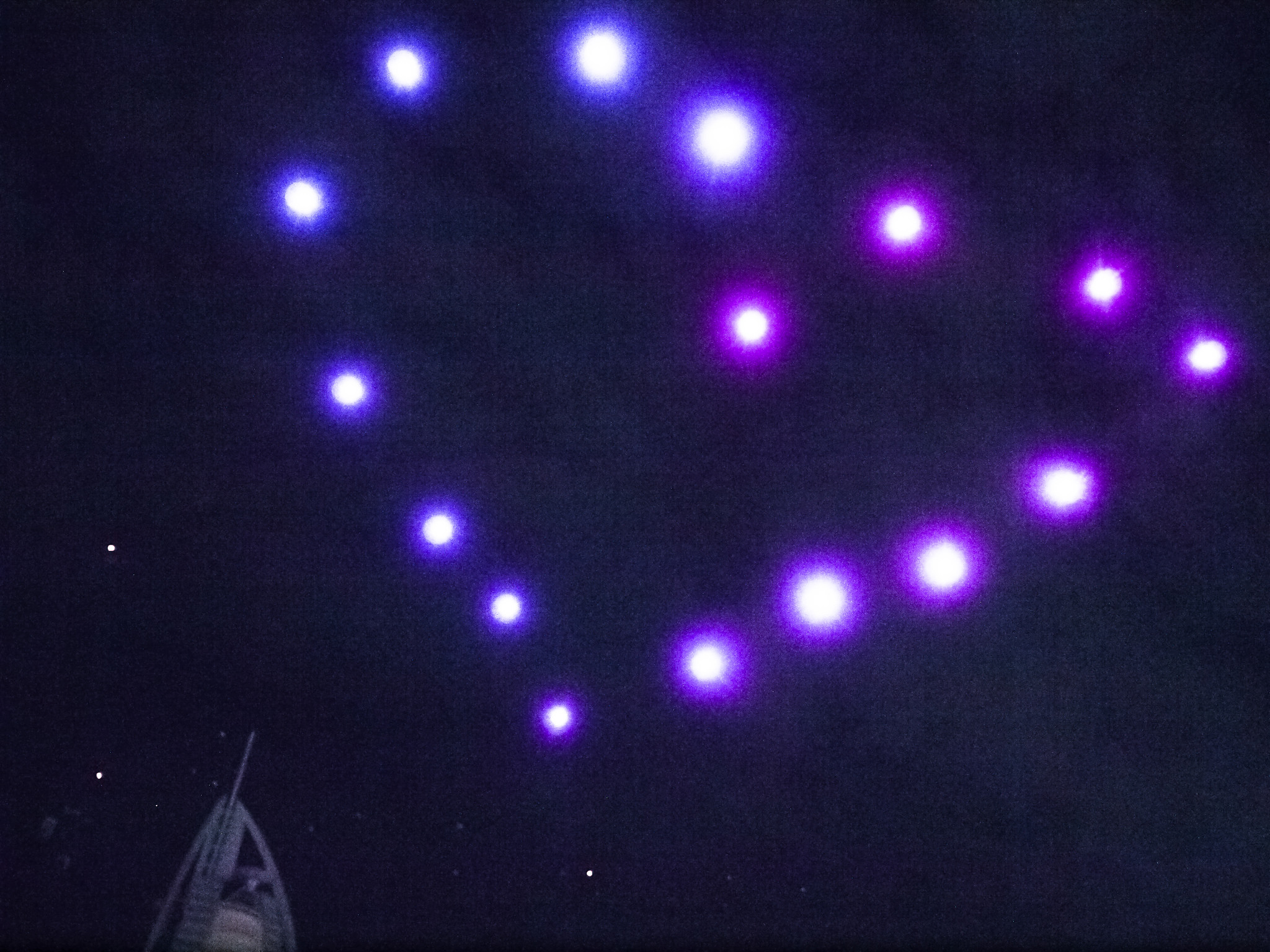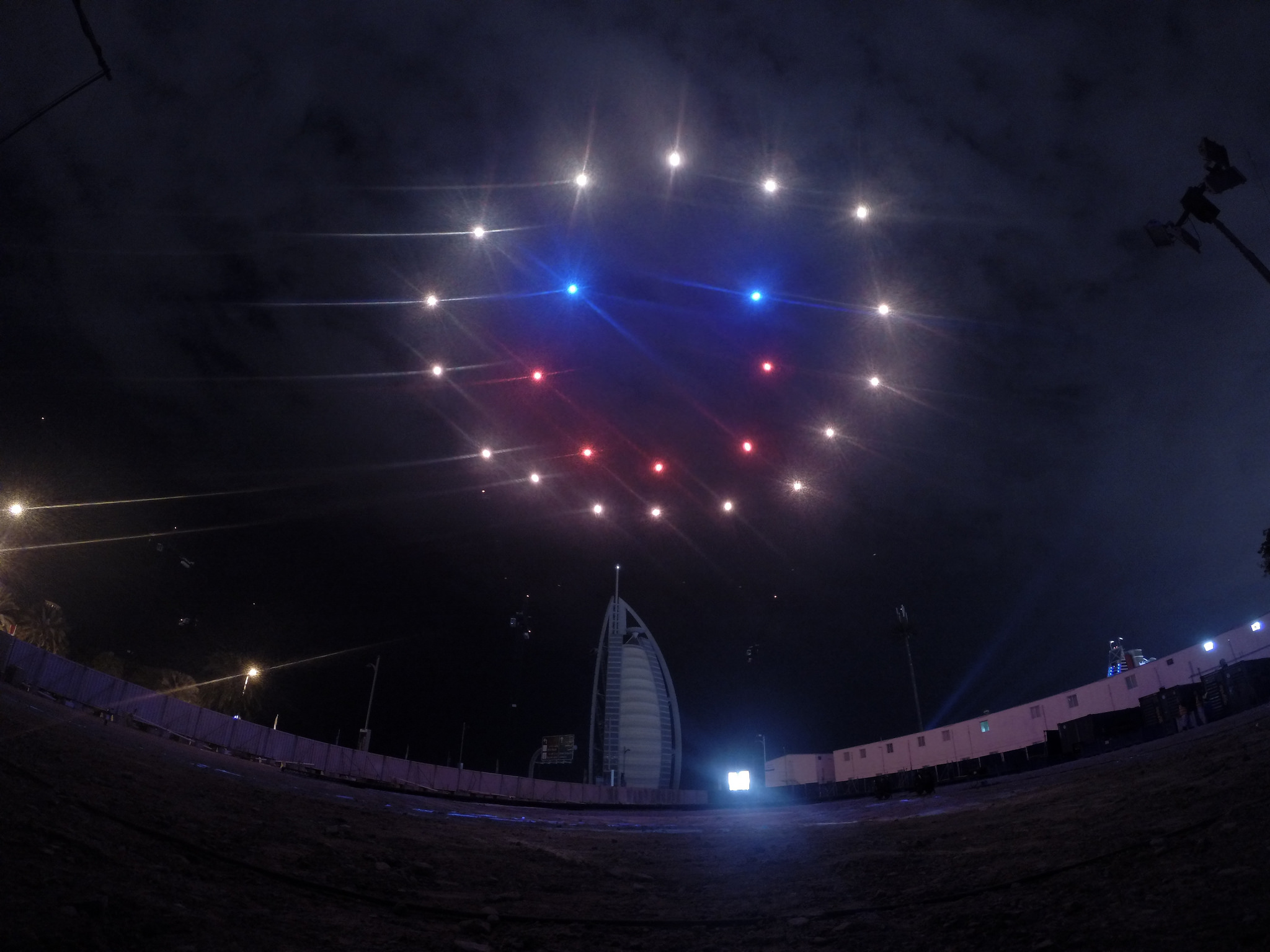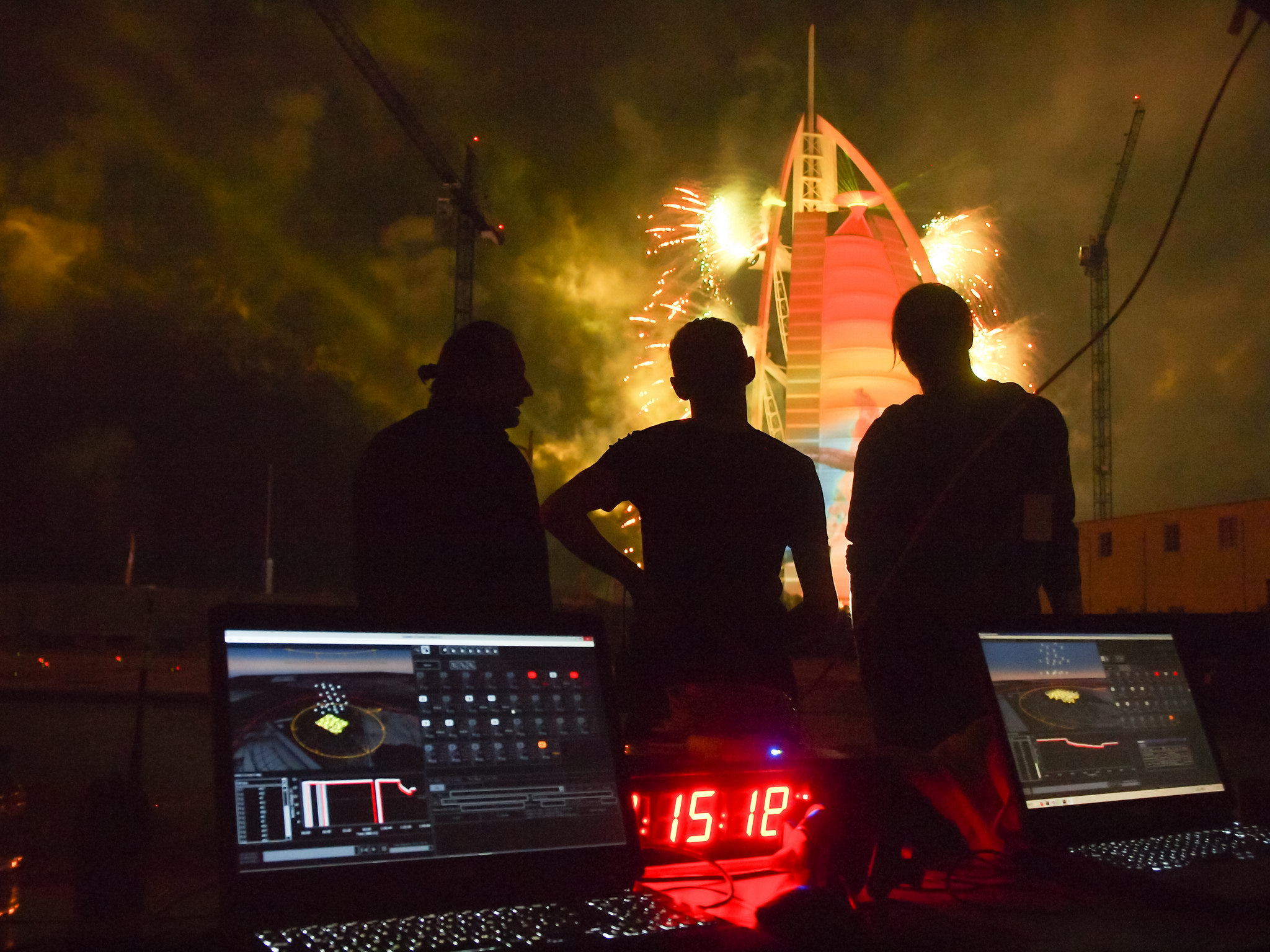Thursday: Outbound Trip
48°17’28.0”N, 14°17’29.6”E, Linz Main Train Station, Thursday, 8 AM. The journey—or let’s call it an adventure—begins. A five-man Ars Electronica Futurelab crew sets out for Dubai in the United Arab Emirates (UAE). 36 Spaxels plus equipment packed in six huge cases had already made the trip to the Arabian Peninsula via cargo plane and been delivered intact a week before. As sophisticated as the technology is, making this swarm of airborne points of light fly still requires human knowhow on site. The out-of-the-box concept remains a vision.
The train ride from Linz to Vienna. The latest modifications to the show design arrived last night from the producer, HQ Creative, along with a rendering of the 28-minute extravaganza and the time code that specifies down to the second when the Spaxels’ appearance begins. But that won’t be the final version. At Vienna International Airport, shortly before passengers’ smartphones have to be switched to flight mode, an e-mail arrives with further details. But that’s to be expected at an event of these dimensions. What’s essential now is to spend a couple of days at the venue to adapt the Spaxels’ show to the prevailing local conditions. But more about that later.

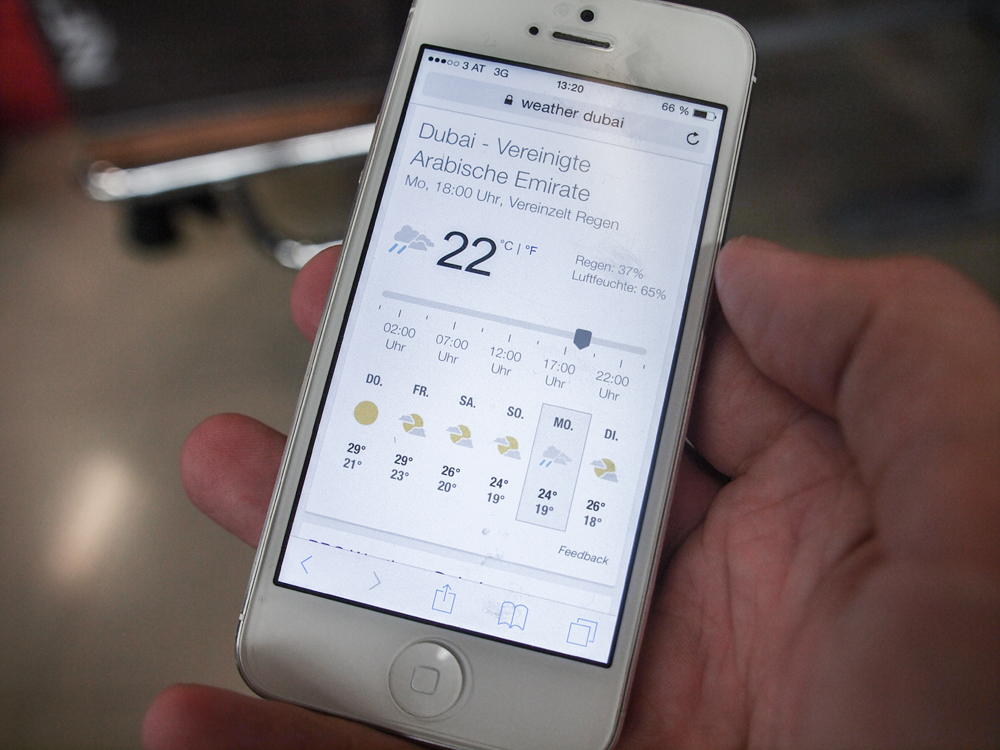
There aren’t many hours in a year in which the entire Spaxels crew is itself aloft. After all, the development and control of the flights is done on the ground. 10:30 PM local time: our aircraft is preparing for landing in Dubai. In contrast to foggy November days in Linz, the weather here is quite pleasant, with a daytime high of 28°C. Nevertheless, there’s slight cause for concern. In this place that averages five rain days a year, a 37% chance of showers is forecast for—wouldn’t you know it—Monday at 6 PM, which is showtime. Otherwise, the probability is 0-1%. So, there’s a chance that the festivities will have to be postponed a day or two, but nothing’s definite yet. The crew arrives, having brought along the necessary flexibility, no small amount of adaptability, and the right electrical socket adapters in their luggage.
Friday: Setup & Initial Testing
25°08’09.2”N, 55°11’18.7”E, Jumeirah Hills, Dubai, 9:45 AM. After a short night in our hotel, the schedule calls for utilizing this day for important technical preparations, since the Spaxels won’t be part of the full-dress rehearsal yet. And there’s good news on the weather front: Monday is looking a lot better. But nothing’s been finalized, and there are still scattered clouds moving through.
The venue: The festivities celebrating the 43rd National Day are being staged in one of Dubai’s most expensive residential neighborhoods, a few hundred meters from the beach and the Burj Al Arab hotel, the city’s world-famous landmark. For the show, a complete ad-hoc stage with all necessary appurtenances is being quickly set up on a vacant parcel. The content to be presented in Heritage Village has to do with the traditions of this Arabic culture. The huge grandstand offers seating for 3,500 guests and VIPs.
The Spaxels’ 21-by-26-meter airfield located 20 meters behind the stage was set up prior to the crew’s arrival and their basic infrastructure was already in place. The Spaxels Headquarters features workspaces, battery charging stations and technical equipment. Right next to it is another tent containing two more workspaces with a view of the takeoff & landing area. The control, coordination and monitoring of the Spaxels is done from here via radio antennas.
First, all technical equipment has to be unpacked, plugged in and set up. Once that’s done, the crew can get busy with the individual Spaxels. While the welcome shade furnished by the gigantic video screen gradually vanishes and the racket being made by the construction workers cavorting across scaffolding to install the stage decor proves capable of overpowering even the din of a bank of electrical generators right next to our tents, markings are applied to the airfield.
Every takeoff/landing position on the pad is assigned a number; so is each Spaxel, each battery, each storage drawer. After having been transported, all the Spaxels get a check-up and the first parts of all the batteries for the 36 drones that have made the trip are loaded. That means: three battery sets—A, B and C—for each of the 36 drones, and thus more than 100 specially designed power packs, which also have to be plugged in and unplugged at precisely the right time, and then installed in the Spaxels.
So, no rain on Monday. The wind speed at 12 Noon is almost 5 meters/second; speeds of up to 6 m/s are no problem for the Spaxels. Whether they can deal with speeds higher than that is a question that only testing can answer.
The hardware is one thing; programming the show design is quite another. But before each individual Spaxel can be adjusted to the program sequence, the corresponding GPS coordinates and the commands for the performance’s routines, a few points are still open. Will additional changes be made to the time code of the whole show when, for example, the jumbo projection screen on the stage is split and the two halves separate as the Spaxels ascend into the night sky? Such questions now have to be answered as quickly as possible.
Since both tents are equipped with air conditioning and lighting, crew members can take a Spaxel in hand and literally walk it around the takeoff & landing zone to register the actual GPS data. This is because it’s conceivable that the GPS signals are slightly off—for example, due to the stage’s giant steel scaffolding and the nearby high-rise buildings, or because the coordinates of the satellite image don’t correspond precisely to the facts and circumstances on the ground. Thanks to this “walking test,” the Spaxels could thus almost be used for surveying purposes. If a Spaxel is carried onto the grandstand from point A to point B, the actual coordinates of the individual spectators are noted as well. All of this information is important for the show design.
Some Spaxels—not all, but a few—take to the air on Day 1 for test purposes. The sun sets. It’s almost 6:30 PM, the exact time the swarm will be lifting off in a couple of days. And this is precisely when it starts to get windy. It’s no longer 6 m/s; the weather station the crew has set up shows that the digit has flipped: 9 m/s.
This is one of the benefits of every Spaxels show. No matter where they fly—in frigid Umea, Sweden at -10°C with snowfall, in Bergen, Brisbane, Sharjah, Linz, Ljubljana or London—the Ars Electronica Futurelab crew gains experience and documents each individual step in a constant effort to enhance the Spaxels’ performance and to develop them further.
But back to the wind—over the course of the evening, the gusts blow in with more and more desert sand. Dusting off the equipment, notebooks and mouse pads becomes a regular necessity. Test flights show that the Spaxels perform a lot better in high winds when the top cover is removed.
And if it most probably won’t rain a drop, then the covers aren’t even necessary anymore. Another test flight confirms the suspicion that, even if the wind whips up a bit, the Spaxels will come through with flying colors, even if it costs a little more energy for them to hold their own aloft in comparison to a low-wind environment.
Additional details with respect to the show design have arrived—the symbols that the Spaxels will draw in the night sky will be tilted slightly more to make them more easily visible by the spectators. The time for the first—and probably not last—programming has arrived.
The information that’s fed into each individual Spaxel is what it needs for its own individual flight. All questions are answered: When do you have to be where, and when do you light up in which color? What do you do when the signal to the control unit is lost? Where may you under no circumstances fly, and where do you have to land? The program is preset; nevertheless, ground control personnel can intervene in certain routines. It’s even possible to stealthily add a Spaxel or two to the swarm; after all, they’re visible only when they light up.
It’s late. The wind is blowing desert sand not only into the tent but into the keyboards and the computers’ air vents. When the Spaxels crew calls it a night and heads from the airfield behind the stage back to the hotel, the construction workers scattered around the stage sets are still at it with their hammers and screwdrivers.
Saturday: Individual Tests
“Let it snow, let it snow, let it snow” – Following a merry, somewhat Christmassy breakfast in the hotel, all five crew members drive back to the site. Unfortunately, there’s simply no time for some downhill runs on the local indoor ski slope. A full day of testing is on the agenda.
There are still a few unanswered questions: How does the Spaxel formation actually look from the grandstand? And from the VIP section? Are changes to the show design still necessary? Will the authorities permit closure of the nearby road? If not, the Spaxels show with all 30 units won’t be able to fly in the desired formation. Wind is another factor that will be on the crew’s list of concerns until Monday. But that’s still a ways off.
Martin, Homer, Uter, Rod, Lancel, Melisandre—Spaxels don’t just have interchangeable numbers; they have permanent names too. And just as their names are personalized, so too do they receive customized maintenance. They’re started and tested individually as well. Every deviation from the norm is noted to then be able to perform the necessary repairs. The Spaxels’ flying fuselage, the Hummingbird, is provided by Germany-based Ascending Technologies. The LED module, and the control hardware and software were developed by the Ars Electronica Futurelab.
It all began with a vision: rendering three-dimensional figures in the night sky and thus going beyond the 2-D realm of conventional jumbo screens. Maybe the inspiration came from the flocks of pigeons that often cruise the airspace around the Ars Electronica Futurelab in Linz. In any case, a swarm of 49 drones made its debut on the banks of the Danube at the voestalpine Klangwolke in September 2012. A lot’s happened since then—for instance, they’re now equipped with a substantially brighter LED system for enhanced visibility in the dark.[youtube=https://www.youtube.com/watch?v=rkU3mE599EI]
It gets dark relatively early now; after all, it’s late November and, even in Dubai, the sun sets just after 5 PM. All the Spaxels are in position on the temporary airfield; each one is individually activated and flown. The first swarm flight will probably take place on Sunday, since the adjacent road has to be closed for an adequate safety zone to be in place.
Meanwhile, the unit to display the time code for the whole show has arrived. Strict compliance is the order of the day! It’s not clear yet how long the pause between the last two scenes will be. If yet another change is made to the routine here, all the Spaxels will have to be manually “flashed”—i.e. reprogrammed—and that takes both time and knowhow, since the problems that can crop up are many and varied. If a Spaxel can’t be fixed on the spot, it’s simply replaced by another and taken back to Linz for repairs.
The tests that the crew has conducted over the last few hours have yielded some valuable findings and insights, all of which are documented and jointly discussed. And a visitor has been attracted to our brightly-lit tent: a prowling alley cat. So, time to call it a day.
Sunday: The Swarm Lifts Off
Sunday Noon: the tents are opened, the radio antennas are in place, and the batteries of Series B are plugged into their sockets. The Spaxels, on the other hand, are still in their drawers, where they’re better off than in direct sunlight.
The temperature is about 24°C with sparse clouds and light wind, which makes for a very pleasant day in Dubai. And the Spaxels crew has just been notified that the road closure during the full rehearsal this evening has been authorized. Initially, two take-off opportunities on Sunday were planned—so, at least one is doable.
The 30 Spaxels will take off in several groups, whereby the top group will be the first to get airborne and the last to land. Order is called for in a three-dimensional space. The quadcopters’ altitude and the figures they’ll be forming necessitate a safety zone on the ground. Since the Spaxels’ midair performance space includes the airspace directly above Jumeirah Road, this six-lane artery has to be temporarily closed.
A new time code has arrived. The show design is updated again and the necessary individualized data is fed into each Spaxel. Not only is there a maximum weight a Spaxel can get aloft; there’s also a limit to the quantity of data it can store. Videos of individual tests from spectators’ points of view aid the crew in assessing whether the Spaxels’ figures can be seen by every audience member. 15 Spaxels, all even-numbered, are carried onto the pad for the last of the final tests to be conducted. In order to minimize the risk associated with a flight according to this new choreography, the crew decides that only half the Spaxels will get airborne today. On this final day of testing, the figures that the flying points of light will render in the night sky can only be imagined.
“Spirit of the Union” is the programmatic title of the 28-minute show that’s being staged here in Dubai to celebrate the UAE’s 43rd National Day. Countless performing artists and extras make up the cast of an extravaganza that proudly recounts the history of the Emirates and the short time it took to transform a village of pearl fishers into a metropolis of glittering skyscrapers in the middle of a desert. The narrative elaborates on the founding fathers as well as the nation’s values, goes into building bridges to the younger generation, and has something to say about new media as well. And this is precisely where, in Act IV, the Spaxels come in. The gigantic screen will divide and open to reveal the space pixels and, in the background, the Burj al Arab, Dubai’s emblematic landmark that has been the world’s tallest luxury hotel ever since it was built 15 years ago.
In the dress rehearsal, only a few Spaxels are visible. The Burj al Arab is the projection screen of a test pattern that will play a role in the fireworks that follow the show. The lighting atop the construction cranes standing next to the theater is still a disruptive element, but they’ll go dark tomorrow evening. The temporary stage is really shaping up. A section of the green artificial turf has already been rolled out and palm fronds adorn the numerous cell-phone masts and towers around the grounds.
All 15 Spaxels make a pinpoint landing, safe and sound. Following the test, all the batteries are recharged. And the kitty that’s adopted us stops by for another visit. Time for a final round of checks and tweaks. By this time tomorrow, the production will long since have been a wrap.
Monday: It’s Showtime!
B-batteries: the B-batteries will be the ones powering the Spaxels ascent this evening. It’s an uncommonly cloudy day here in Dubai. You can even feel raindrops, though they’re few and far between. This is the second time it’s rained here this year. Of course, it’s wonderful to be privileged to experience this rare occurrence, but the Spaxels are currently topless. The flight will go off as planned only if there’s no rain. But no worries—this Dubai downpour ends after a few minutes. And hopefully, that’s the extent of the precipitation for a while. The cat fails to show up today, evidently replaced by the security force’s sniffer dogs. In the early afternoon, all personnel must leave the premises so the police’s canine corps can scour the grounds for suspicious objects.

The time code is set; departure time is 18:35 sharp. Now, all that remains to be done is to program the Spaxels that didn’t get airborne yesterday. The quadrocopters sit in their storage drawers before they’re charged up to 100%. Now, it’s time to bring them out, install the batteries, and bring each unit out to its takeoff position. In the background, the show is already in progress. The Spaxels will be the final highlight prior to the traditional pyrotechnic display. It’s quiet; only a few security guards are scurrying about. Loudspeaker announcement; “Road closure implemented!” The Spaxels lift off in squadrons—all you can see are tiny control lamps; all you can hear is the whirring of the rotors. Three, two, one, play.
The 30 Spaxels take off just as the music begins and perform their 8-minute routine. There’s practically no wind on this evening, so it’s absolutely no problem for the quadcopters to maintain a safe distance: six meters apart. The GPS signal is good; it’s not raining. And there, you can already hear it: the signature melody of Act IV. Behind the jumbo screen, the 30 Spaxels begin to execute their illuminated maneuvers right on time.
Sporadic blinking, smiley, heart and arrows, big flash and a multihued rain of pixels. The Spaxels enchant the 3,500 spectators on site in Dubai and the audience watching the state broadcasting company’s live coverage on TV. All units are on the correct flight paths specified by their three coordinates. Then the stage opens to delighted applause from the audience. The Spaxels now turn over the spotlight to the traditional fireworks that mark the annual National Day celebration in Dubai.
Meanwhile, the Spaxels, their LED modules switched off, are in the process of landing in orderly groups on their backstage airfield to the accompaniment of a high-decibel display of pyrotechnic artistry. Not a single quadcopter touched down beyond the landing zone boundary; all are back, more of less on the spots they took off from, to the extent the local GPS signal quality makes possible. Shutting down the Spaxels can wait a bit. All around: expressions of relief. The crew members get to enjoy a bit of pure relaxation while partaking of the fireworks above the beach and surrounding the Burj al Arab. Control lights are blinking on the landing pad as hundreds of rockets slash across the sky. After another quarter-hour, the show concludes.
The sheiks are heading for home as the Spaxels are cleared away and repacked in their storage cases. The tent is vacated. Mission accomplished. Thanks to the extensive pre-flight testing, everything went off as planned. At 5 the next morning, it’s time to rise and shine to not miss the flight back to Austria. After all, not only little quadcopters have their time codes; airlines’ jumbo jets do too.
To learn more about the Ars Electronica Futurelab’s Spaxels, click on this link ars.electronica.art/spaxels or visit the Ars Electronica Blog.
Photos: Martin Hieslmair
